 | –≠–ª–µ–∫—Ç—Ä–æ–Ω–Ω—ã–π –∫–æ–º–ø–æ–Ω–µ–Ω—Ç: OM5193H | –°–∫–∞—á–∞—Ç—å:  PDF PDF  ZIP ZIP |
Document Outline
- CONTENTS
- 1 FEATURES
- 1.1 Servo control
- 1.2 Motor control
- 1.3 Miscellaneous items
- 2 APPLICATIONS
- 3 GENERAL DESCRIPTION
- 3.1 Overview
- 3.2 Servo controller
- 3.3 Spindle and voice coil motor
- 3.4 Safety functions
- 4 QUICK REFERENCE DATA
- 5 ORDERING INFORMATION
- 6 BLOCK DIAGRAMS
- 7 PINNING
- 8 FUNCTIONAL DESCRIPTION
- 8.1 Serial interface
- 8.2 Commutation and sleep mode
- 8.3 Commutation control
- 8.4 10-bit ADC with 7 analog inputs
- 8.5 10-bit VCM DAC
- 8.6 Reference voltage
- 8.7 Stand-alone op-amps
- 8.8 Analog switch
- 8.9 Charge pump voltage
- 8.10 Spindle driver
- 8.11 VCM driver
- 8.12 Park the VCM
- 8.13 Precharge the VCM
- 8.14 Brake the motor
- 8.15 Power-on reset
- 8.16 Thermal monitor and shutdown
- 8.17 Power supply isolation
- 8.18 Thermal behaviour
- 9 LIMITING VALUES
- 10 HANDLING
- 11 THERMAL CHARACTERISTICS
- 12 CHARACTERISTICS
- 13 APPLICATION INFORMATION
- 14 PACKAGE OUTLINE
- 15 SOLDERING
- 15.1 Introduction
- 15.2 Reflow soldering
- 15.3 Wave soldering
- 15.4 Repairing soldered joints
- 16 DEFINITIONS
- 17 LIFE SUPPORT APPLICATIONS

DATA SHEET
Product specification
File under Integrated Circuits, IC11
1998 Nov 02
INTEGRATED CIRCUITS
OM5193H
Disk drive spindle and VCM with
servo controller

1998 Nov 02
2
Philips Semiconductors
Product specification
Disk drive spindle and VCM with
servo controller
OM5193H
CONTENTS
1
FEATURES
1.1
Servo control
1.2
Motor control
1.2.1
Spindle motor driver
1.2.2
Voice coil motor driver
1.3
Miscellaneous items
2
APPLICATIONS
3
GENERAL DESCRIPTION
3.1
Overview
3.2
Servo controller
3.3
Spindle and voice coil motor
3.4
Safety functions
4
QUICK REFERENCE DATA
5
ORDERING INFORMATION
6
BLOCK DIAGRAMS
7
PINNING
8
FUNCTIONAL DESCRIPTION
8.1
Serial interface
8.2
Commutation and sleep mode
8.3
Commutation control
8.3.1
Blanks, Watchdog and Start-up delays
8.3.2
Comdelim delay
8.4
10-bit ADC with 7 analog inputs
8.4.1
Input channels
8.4.2
Input ranges
8.4.3
Conversion modes
8.4.4
Programming register#0
8.4.5
Converter clock frequency values
8.5
10-bit VCM DAC
8.6
Reference voltage
8.7
Stand-alone op-amps
8.8
Analog switch
8.9
Charge pump voltage
8.10
Spindle driver
8.11
VCM driver
8.12
Park the VCM
8.13
Precharge the VCM
8.14
Brake the motor
8.15
Power-on reset
8.16
Thermal monitor and shutdown
8.17
Power supply isolation
8.17.1
External isolation diode
8.17.2
External power FET
8.18
Thermal behaviour
9
LIMITING VALUES
10
HANDLING
11
THERMAL CHARACTERISTICS
12
CHARACTERISTICS
13
APPLICATION INFORMATION
14
PACKAGE OUTLINE
15
SOLDERING
15.1
Introduction
15.2
Reflow soldering
15.3
Wave soldering
15.4
Repairing soldered joints
16
DEFINITIONS
17
LIFE SUPPORT APPLICATIONS

1998 Nov 02
3
Philips Semiconductors
Product specification
Disk drive spindle and VCM with
servo controller
OM5193H
1
FEATURES
1.1
Servo control
∑
10-bit VCM Digital-to-Analog Converter (DAC)
∑
7-channel 10-bit Analog-to-Digital Converter (ADC)
∑
Programmable spindle commutation control logic
∑
3-wire serial interface
∑
Two stand-alone operational amplifiers (op-amps) with
outputs connected to the ADC
∑
Analog multiplexer with two inputs used to select VCM
seek mode or track-following mode.
1.2
Motor control
1.2.1
S
PINDLE MOTOR DRIVER
∑
3-phase output motor driver
∑
1.9 A maximum available start-up current
∑
Total R
ds(on)
= 0.6
(typical) at 25
∞
C
∑
Back ElectroMotive Force (BEMF) processing for
sensorless motor commutation
∑
Linear current control
∑
External current sense resistor
∑
External current control loop compensation
∑
Adjustable slew rate control
∑
Short-circuit brake
∑
Adjustable brake-after-park delay time.
1.2.2
V
OICE COIL MOTOR DRIVER
∑
1.5 A maximum current capability
∑
Total R
ds(on)
= 0.8
(typical) at 25
∞
C
∑
Linear class AB output with low cross-over distortion
delay
∑
Precision current control loop with external current
sense resistor
∑
Programmable seek and track-following mode with
adjustable current loop gain
∑
External current control loop compensation
∑
Precharge during brake mode
∑
20 kHz current control loop bandwidth
∑
Parking function
∑
Adjustable park voltage with limiter.
1.3
Miscellaneous items
∑
Precision low voltage 5 and 12 V power monitor with
hysteresis
∑
Precision internal voltage reference for servo and power
control circuits
∑
Thermal sense circuit with over-temperature shutdown
sensor
∑
Internal charge pump voltage generator
∑
Automatic brake-after-park at power-down, thermal
shutdown or sleep mode
∑
Sleep mode: low power consumption mode.
2
APPLICATIONS
∑
12 V hard disk drive products.
3
GENERAL DESCRIPTION
3.1
Overview
The OM5193H is a combination of a voice coil motor and
a spindle motor driver with embedded servo controller
designed for use in disk drives. Configuration and control
registers are set via a 3-wire serial port running up to
30 MHz to interface commonly to a microcontroller or a
digital signal processor.
The device operates at 5 and 12 V power supplies and
integrates safety functions such as power stages
overvoltage protection, power and temperature monitor,
over-temperature shutdown and dynamic
brake-after-park.
The device is contained in a QFP80 package with 18 pins
connected to the leadframe thus providing low thermal
resistance.
3.2
Servo controller
The servo controller includes the following circuits:
∑
3-wire serial interface
∑
Spindle commutation logic
∑
A 10-bit ADC with 7 inputs selected by an internal
multiplexer
∑
A 10-bit VCM DAC with 1.5, 2.5 and 3.5 V voltage
references
∑
Two low-offset stand-alone op-amps
∑
Analog multiplexer with 2 inputs.

1998 Nov 02
4
Philips Semiconductors
Product specification
Disk drive spindle and VCM with
servo controller
OM5193H
The serial interface is used:
∑
To adjust the timing parameters for proper spindle
commutation sequence
∑
To accurately adjust head positioning via the 10-bit VCM
DAC
∑
To set VCM seek or track-following mode via the
low-impedance switch
∑
To select and process analog signals via a 7-channel
multiplexer connected to the 10-bit ADC.
The spindle commutation logic circuit ensures proper
spindle start-up (no reverse rotation) and commutation
sequence for the spindle driver by processing BEMF
sensing circuit output signals.
The two stand-alone op-amps, with the inputs connected
to the read channel IC, provide servo track signals
processed by the microcontroller to perform accurate
track-following mode.
3.3
Spindle and voice coil motor
The OM5193H drives a 3-phase brushless, sensorless DC
spindle motor and a voice coil motor.
Spindle and voice coil motor power stages with low R
ds(on)
and high current capability are suitable for mid-end and
low-end 12 V disk drives. Power stages are designed in
such a way that external Schottky diodes are not needed.
Spindle current is sensed by an external resistor and
monitored by the external signal SPCC (SPindle Current
Control). Spindle speed is regulated by the microcontroller
via the ZCROSS signal (Zero CROSSing detection
frequency output). BEMF comparators provide the digital
zero crossing signals. These are processed by the
commutation logic circuit to properly switch-on and
switch-off spindle power drivers thus ensuring the rotation
of the motor.
The control of the heads positioning is accomplished by
the internal 10-bit VCM DAC. Seek and track-following
VCM current loop gain is set by external resistors. VCM
zero current is referenced to the 2.5 V internal voltage
reference.
An internal precharge of the actuator (magnetic latch)
during brake mode guarantees total control of the current
when VCM starts running without current spikes.
3.4
Safety functions
The OM5193H is protected against transient voltage
spikes that are generated by the inductive loads of spindle
and VCM.
Power supplies and temperature are monitored in order to
guarantee data reliability and self-protection of the device
in case of power loss or temperatures beyond maximum
rating.
Park and brake functions secure heads and disk media in
case of power-down or high temperature failure. This
function is also activated by the sleep mode.
An internal temperature monitor is available to monitor the
chip temperature and thus prevents over-temperature
shutdown. Internally connected to the ADC channel 4, it
can be used by the microcontroller as an early
`temperature-too-high' warning during a long VCM seek
sequence.
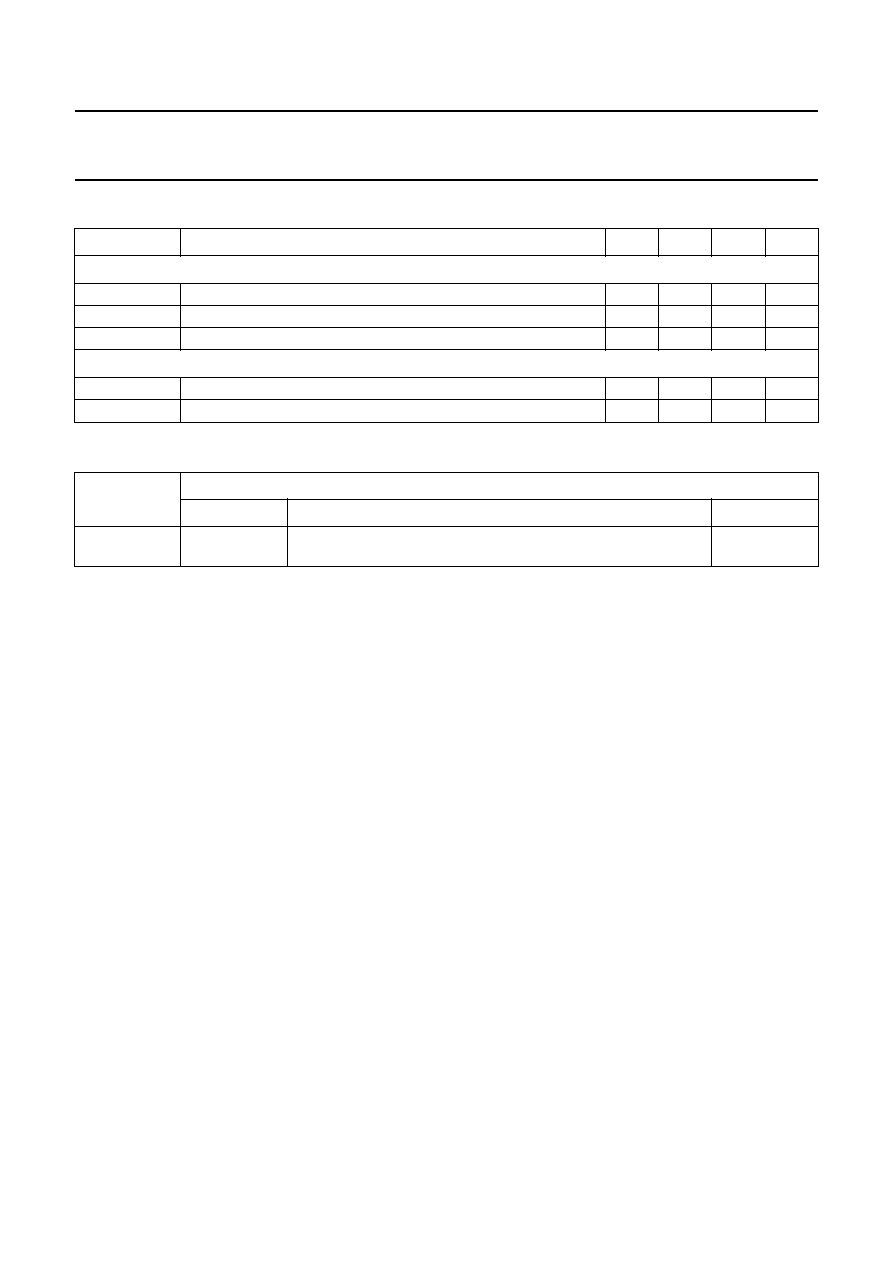
1998 Nov 02
5
Philips Semiconductors
Product specification
Disk drive spindle and VCM with
servo controller
OM5193H
4
QUICK REFERENCE DATA
5
ORDERING INFORMATION
SYMBOL
PARAMETER
MIN.
TYP.
MAX.
UNIT
Supply voltage
V
DDA1
5 V analog supply voltage
4.5
5.0
5.5
V
V
DDD
5 V digital supply voltage
4.5
5.0
5.5
V
V
DDA2
12 V analog supply voltage
10.8
12.0
13.2
V
Drivers
I
SPOUT
spindle start-up current
-
-
1.9
A
I
VCMRUN
VCM current
-
-
1.5
A
TYPE
NUMBER
PACKAGE
NAME
DESCRIPTION
VERSION
OM5193H
QFP80
plastic quad flat package; 80 leads (lead length 1.95 mm);
body 14
◊
20
◊
2.8 mm
SOT318-2
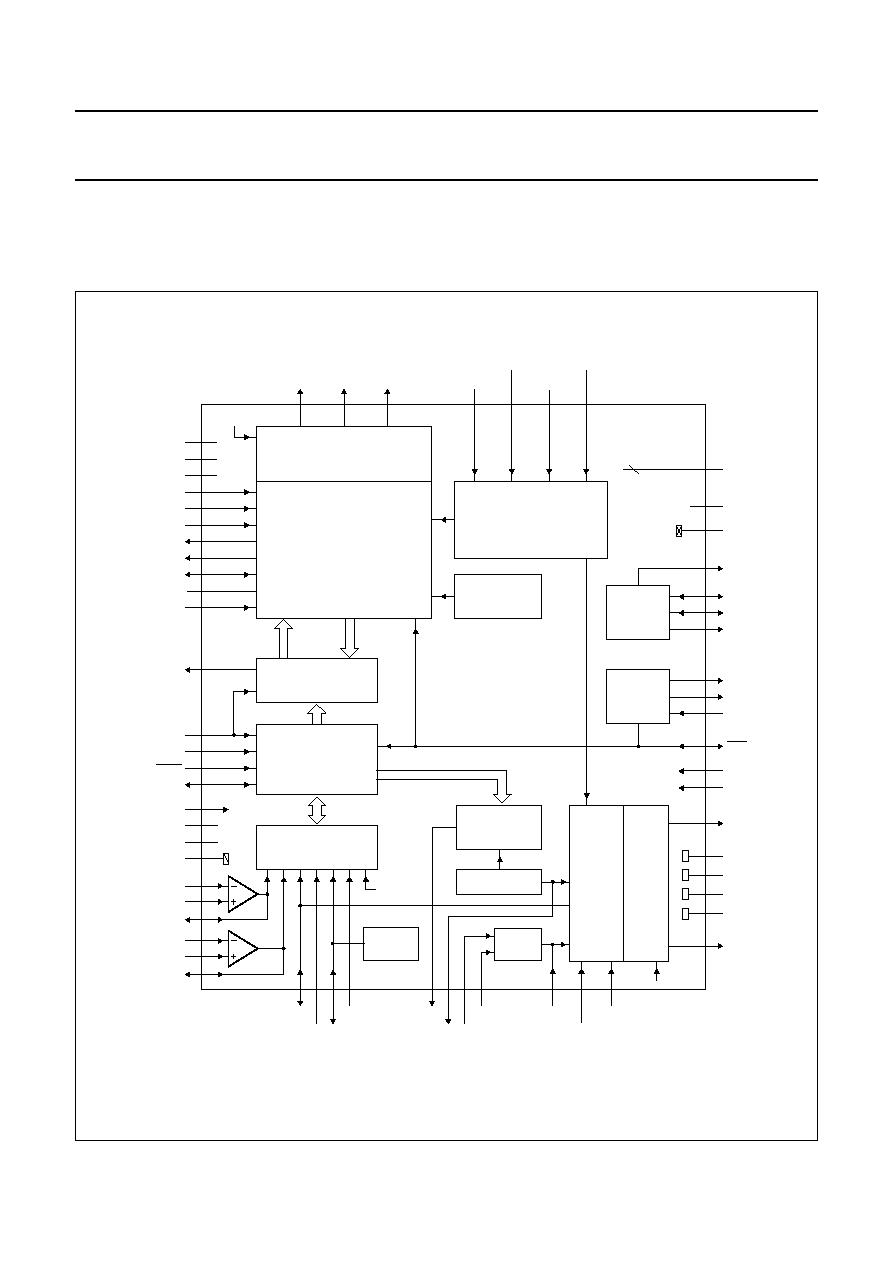
1998 Nov 02
6
Philips Semiconductors
Product specification
Disk drive spindle and VCM with
servo controller
OM5193H
6
BLOCK DIAGRAMS
Figures 1, 2, 3 and 4 provide block diagrams of the OM5193H servo and motor control (top level diagram, servo
controller, spindle motor driver and voice coil motor driver).
Fig.1 Block diagram, top level.
handbook, full pagewidth
MGM972
7-CHANNEL
10-BIT ADC
SERIAL
INTERFACE
COMMUTATION
LOGIC
POWER
STAGE
SPINDLE
CONTROL
10
CLAMP1
CLAMP
72
COMA
COMB
COMC
ACROSS
BCROSS
CCROSS
MOTA
74
MOTB
3
48
50
49
51
MOTC
12
SLEW
14
SPCCOUT
13
SPCC
73
MOTSENSE3
24
CLOCK
23
SCLOCK
35
PESAMPN
36
PESAMP
26
SCANTEST
44
VDDA1
15
VDDA2
39
AGND
21
22
SDATA
25
ZCROSS
76
MOTSENSE2
2
MOTSENSE1/
SPSENSEH
11
GNDS/SPSENSEL
9
CT
55
CLAMP2
56
CLAMP3
0
1
2
3
4
5
6
SDEN
29
ADC[1]/DIFOUT
37
INTINN
0.5VDDA1
38
NIVCM
69
IVCM
62
CPOR
45
CHK12
47
CHK5
46
CAPY
18
BSTCP2
17
BSTCP1
16
SWITCHGATE
8
DGND
27
VDDD
20
18
PWRBIAS1
57
PWRBIAS2
77
HEATSINK
1, 4 to 7,
58 to 61, 64 to 67,
70, 75, 78 to 80
INTIN
19
28
30 31 32 33
34 40 42 41
43
53
52
ADC[0]/INTOUT
ADC[2]/SOUT
ADC[3]
ADC[4]/TEMP
ADC[5]
THERMAL
MONITOR
THERMAL
SHUTDOWN
VCM
SWITCH
VCM
CONTROL
POWER
STAGE
BANDGAP
CLAMP
10-BIT
VCM DAC
POWER-ON
RESET
CHARGE
PUMP
PARK AND BRAKE
TRACKFWSELECT
SEEKSELECT
DACOUT
REF2V5
VCMSENSEL
VCMSENSEH
VCMIN
GNDV
54
GNDVCM1
71
GNDVCM2
68
GNDVCM3
63
OM5193H
PARKVOLT
BRAKEDELAY
BRAKEADJH
BRAKEPOWER
POR
A2
A1
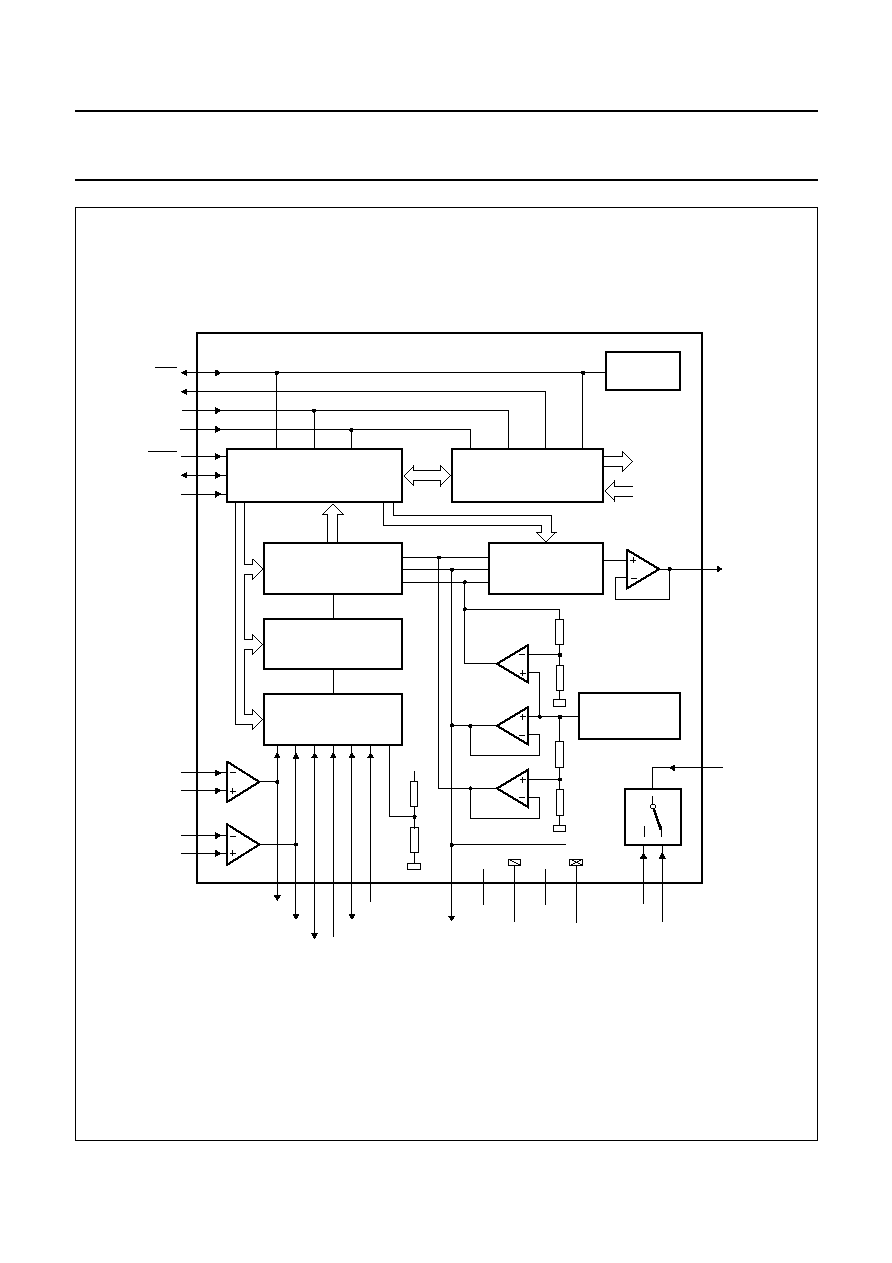
1998 Nov 02
7
Philips Semiconductors
Product specification
Disk drive spindle and VCM with
servo controller
OM5193H
Fig.2 Block diagram, servo controller.
handbook, full pagewidth
MGM973
INPUT
MULTIPLEXER
36
PESAMP
35
PESAMPN
29
ADC[1]/DIFOUT
37
INTINN
VDDA1
Vref2V5
Vref3V5
Vref1V5
Vref2V5
38
INTIN
23
SCLOCK
22
SDATA
21
26
SCANTEST
24
CLOCK
25
ZCROSS
19
28
30 31 32 33
ADC[0]/INTOUT
ADC[2]/SOUT ADC[3]
ADC[4]/TEMP
ADC[5]
A2
A1
40
39
REF2V5
VDDD
AGND
DGND
RANGE
ADAPTER
10-BIT ADC
SERIAL INTERFACE
COMMUTATION LOGIC
10-BIT VCM DAC
20
VDDA1
44
for VCM
VCM switch
27
2.5 V BANDGAP
41
43
42
TRACKFWSELECT
SEEKSELECT
VCMIN
34
DACOUT
OM5193H
COMA
COMB
COMC
ACROSS
BCROSS
CCROSS
POWER-ON
RESET
POR
SDEN

1998 Nov 02
8
Philips Semiconductors
Product specification
Disk drive spindle and VCM with
servo controller
OM5193H
Fig.3 Block diagram, spindle motor driver.
handbook, full pagewidth
MGM974
SLOPE
CURRENT
CONTROL
SPINDLE
SWITCH
DECODER
PREDRIVER
PREDRIVER
PREDRIVER
THERMAL
SHUTDOWN
THERMAL
MONITOR
POWER-ON
RESET
CHARGE
PUMP
BEMF
COMPARATOR
MOTB
74
3 MOTC
MOTA
72
CT
2
76
73
12
11
13
14
SLEW
RSLEW
RSPSENSE
MOTSENSE1/
SPSENSEH
MOTSENSE2
MOTSENSE3
GNDS/SPSENSEL
SPCC
SPCCOUT
CSPCCOUT
9
SENSE
AMPLIFIER
CONTROL
AMPLIFIER
ACROSS
BCROSS
to commutation logic
CCROSS
8
SWITCH GATE
10
55
56
CLAMP1
CLAMP2
CLAMP3
VDDA2POWER
32
ADC[4]/TEMP
19
POR
47
CHK12
44
15
45
16
46
CHK5
Vref (from VCM)
Ibrake (from VCM)
COMA
COMB
COMC
from
commu-
tation
logic
CCHK5
CCHK12
17
18
77
57
CCAPY
VCAPY
CCPOR
VDDA2
VDDA1
CCAPX
CPOR
BSTCP1 BSTCP2
CAPY
PWRBIAS1 PWRBIAS2
OM5193H

1998
Nov
02
9
Philips Semiconductors
Product specification
Disk drive spindle and VCM with
servo controller
OM5193H
This text is here in white to force landscape pages to be rotated correctly when browsing through the pdf in the Acrobat reader.This text is here in
_
white to force landscape pages to be rotated correctly when browsing through the pdf in the Acrobat reader.This text is here inThis text is here in
white to force landscape pages to be rotated correctly when browsing through the pdf in the Acrobat reader. white to force landscape pages to be ...
a
ndbook, full pagewidth
MGM975
VCM
DAC
BRAKE
AFTER
PARK
PRE
DRIVER
PRE
DRIVER
GND
12 V
GNDVCM1
71
GNDVCM2
68
CLAMP3
56
SWITCHGATE
8
CLAMP2
55
CLAMP1
10
NIVCM
69
VCMSENSEL
RVCMSENSE
53
VCMSENSEH
52
IVCM
62
GNDVCM3
63
ERROR
SENSE
ERROR
PARK
REF2V5
RPARKVOLT
RVCMCOMPRC
RFEEDBACK
CVCMCOMPRC
ERROR
master
slave
SWITCH
BANDGAP
Vref
(to spindle)
Ibrake
(to spindle)
VCM switch
42
41
TRACKFWSELECT
SEEKSELECT
34
30
DACOUT
M
PRECHARGE
POWER-DOWN
40
VCMIN
43
BRAKEPOWER
CBRAKEP
RBRAKED
CBRAKED
48
BRAKEADJH
49
BRAKEDELAY
50
PARKVOLT
51
54
ADC[2]/SOUT
GNDV
RVCMSEEK
RVCMTRACKFW
OM5193H
VCAPY
Fig.4 Block diagram, voice coil motor driver.

1998 Nov 02
10
Philips Semiconductors
Product specification
Disk drive spindle and VCM with
servo controller
OM5193H
7
PINNING
SYMBOL
PIN
I/O
DESCRIPTION
HEATSINK
1
-
dissipation pin; internally connected to the leadframe
MOTSENSE1/SPSENSEH
2
analog I/O
sense line of the spindle/spindle sense amplifier input
MOTC
3
analog output
spindle motor power output
HEATSINK
4
-
dissipation pin; internally connected to the leadframe
HEATSINK
5
-
dissipation pin; internally connected to the leadframe
HEATSINK
6
-
dissipation pin; internally connected to the leadframe
HEATSINK
7
-
dissipation pin; internally connected to the leadframe
SWITCHGATE
8
analog output
isolation FET driver
CT
9
analog input
centre tap of the spindle
CLAMP1
10
supply
power stage supply voltage
GNDS/SPSENSEL
11
ground
spindle ground connection/spindle sense amplifier ground
SLEW
12
analog input
spindle motor slope control
SPCC
13
analog input
spindle current control
SPCCOUT
14
analog input
compensation point of the spindle current control loop
V
DDA2
15
supply
12 V analog supply voltage
BSTCP1
16
analog I/O
booster capacitor 1
BSTCP2
17
analog I/O
booster capacitor 2
CAPY
18
analog output
DC-to-DC converter output (19 V)
POR
19
digital I/O
power-on reset signal; active LOW
V
DDD
20
supply
5 V digital supply voltage
SDEN
21
digital input
serial interface data enable; active LOW
SDATA
22
digital I/O
serial interface data line
SCLOCK
23
digital input
serial interface clock line
CLOCK
24
digital input
clock input
ZCROSS
25
digital output
zero crossing detection signal
SCANTEST
26
digital input
scantest mode control; at LOW-level in normal conditions
DGND
27
ground
servo digital ground
ADC[0]/INTOUT
28
analog I/O
ADC channel 0 input/output of the A2 amplifier
ADC[1]/DIFOUT
29
analog I/O
ADC channel 1 input/output of the A1 amplifier
ADC[2]/SOUT
30
analog I/O
ADC channel 2 input/VCM sense amplifier output
ADC[3]
31
analog input
ADC channel 3 input
ADC[4]/TEMP
32
analog I/O
ADC channel 4 input/temperature monitor, thermal shutdown
ADC[5]
33
analog input
ADC channel 5 input
DACOUT
34
analog output
10-bit VCM DAC output
PESAMPN
35
analog input
inverting input of the A1 amplifier.
PESAMP
36
analog input
non-inverting input of the A1 amplifier
INTINN
37
analog input
inverting input of the A2 amplifier
INTIN
38
analog input
non-inverting input of the A2 amplifier
AGND
39
ground
servo analog ground
REF2V5
40
analog output
2.5 V bandgap reference voltage

1998 Nov 02
11
Philips Semiconductors
Product specification
Disk drive spindle and VCM with
servo controller
OM5193H
SEEKSELECT
41
analog input
input for the seek mode
TRACKFWSELECT
42
analog input
input for the track-following mode
VCMIN
43
analog input
VCM control input
V
DDA1
44
supply
5 V analog supply voltage
CPOR
45
analog input
set the POR delay time
CHK5
46
analog output
set the V
DDA1
POR threshold
CHK12
47
analog output
set the V
DDA2
POR threshold
BRAKEPOWER
48
analog input
brake power capacitor
BRAKEADJH
49
analog input
adjust current consumption during park mode
BRAKEDELAY
50
analog input
set the brake-after-park delay time
PARKVOLT
51
analog input
set the park voltage
VCMSENSEH
52
analog input
positive input of the VCM sense amplifier
VCMSENSEL
53
analog input
negative input of the VCM sense amplifier
GNDV
54
ground
VCM ground connection
CLAMP2
55
supply
power stage supply voltage
CLAMP3
56
supply
power stage supply voltage
PWRBIAS1
57
analog input
power stages isolation bias; externally connected to the clamp
HEATSINK
58
-
dissipation pin; internally connected to the leadframe
HEATSINK
59
-
dissipation pin; internally connected to the leadframe
HEATSINK
60
-
dissipation pin; internally connected to the leadframe
HEATSINK
61
-
dissipation pin; internally connected to the leadframe
IVCM
62
analog output
inverted output of the VCM (master stage)
GNDVCM3
63
ground
VCM power stage ground
HEATSINK
64
-
dissipation pin; internally connected to the leadframe
HEATSINK
65
-
dissipation pin; internally connected to the leadframe
HEATSINK
66
-
dissipation pin; internally connected to the leadframe
HEATSINK
67
-
dissipation pin; internally connected to the leadframe
GNDVCM2
68
ground
VCM power stage ground
NIVCM
69
analog output
non-inverted VCM output (slave stage)
HEATSINK
70
-
dissipation pin; internally connected to the leadframe
GNDVCM1
71
ground
VCM power stage ground
MOTA
72
analog output
spindle motor power output
MOTSENSE3
73
analog output
sense line of the spindle
MOTB
74
analog output
spindle motor power output
HEATSINK
75
-
dissipation pin; internally connected to the leadframe
MOTSENSE2
76
analog output
sense line of the spindle
PWRBIAS2
77
analog input
power stages isolation bias; externally connected to the clamp
HEATSINK
78
-
dissipation pin; internally connected to the leadframe
HEATSINK
79
-
dissipation pin; internally connected to the leadframe
HEATSINK
80
-
dissipation pin; internally connected to the leadframe
SYMBOL
PIN
I/O
DESCRIPTION

1998 Nov 02
12
Philips Semiconductors
Product specification
Disk drive spindle and VCM with
servo controller
OM5193H
Fig.5 Pin configuration.
handbook, full pagewidth
OM5193H
MGM976
1
2
3
4
5
6
7
8
9
10
11
12
13
14
15
16
17
18
19
20
60
59
58
57
56
64
63
62
61
55
54
53
52
51
50
49
48
47
46
45
44
43
42
41
HEATSINK
HEATSINK
HEATSINK
PWRBIAS1
CLAMP3
HEATSINK
GNDVCM3
IVCM
HEATSINK
CLAMP2
GNDV
VCMSENSEL
VCMSENSEH
PARKVOLT
BRAKEDELAY
BRAKEADJH
BRAKEPOWER
CHK12
CHK5
CPOR
VDDA1
VCMIN
TRACKFWSELECT
SEEKSELECT
HEATSINK
HEATSINK
HEATSINK
SWITCHGATE
CT
HEATSINK
MOTSENSE1/
SPSENSEH
MOTC
HEATSINK
CLAMP1
GNDS/SPSENSEL
SLEW
SPCC
SPCCOUT
VDDA2
BSTCP1
BSTCP2
CAPY
POR
VDDD
SDEN
SDATA
SCLOCK
CLOCK
21
22
23
24
25
26
27
28
29
30
31
32
33
34
35
36
37
38
39
40
ZCROSS
SCANTEST
DGND
ADC[0]/INTOUT
ADC[1]/DIFOUT
ADC[2]/SOUT
ADC[3]
ADC[4]/TEMP
ADC[5]
DACOUT
PESAMPN
PESAMP
INTINN
INTIN
AGND
REF2V5
HEATSINK
HEATSINK
HEATSINK
PWRBIAS2
MOTSENSE2
HEATSINK
MOTB
MOTSENSE3
MOTA
GNDVCM1
HEATSINK
NIVCM
GNDVCM2
HEATSINK
HEATSINK
HEATSINK
80
79
78
77
76
75
74
73
72
71
70
69
68
67
66
65

1998 Nov 02
13
Philips Semiconductors
Product specification
Disk drive spindle and VCM with
servo controller
OM5193H
8
FUNCTIONAL DESCRIPTION
8.1
Serial interface
The serial interface is a 3-wire bidirectional port for writing
and reading data to and from the internal registers of the
OM5193H. Each read or write will be composed of 16 bits.
For data transfer SDEN is brought LOW, serial data is
presented at the SDATA pin, and a serial clock is applied
to the SCLOCK pin. After the SDEN pin goes LOW, the
first 16 pulses applied to the SCLOCK pin shift the data
presented at the SDATA pin into an internal shift register
on the rising edge of each clock pulse. An internal counter
prevents more than 16 bits from being shifted into the
register. The data in the shift register is latched when
SDEN goes HIGH. If less than 16 clock pulses are
provided before SDEN goes HIGH, the data transfer is
aborted.
All transfers are shifted into the serial port with the MSB
first. The first 4 bits of the transfer contain address and
instruction information. The MSB is the R/W bit which
determines if the transfer is a read (logic 1) or a
write (logic 0).
The remaining 3 bits determine the internal register to be
accessed. The other 12 bits contain the programming
data. In the read mode (R/W = 1), the OM5193H outputs
the register contents of the selected address. In the write
mode (R/W = 0), the OM5193H loads the selected register
with the data presented on the SDATA pin. During sleep
mode, the serial port remains active and register
programmed data is retained.
SCLOCK is driven by the microcontroller. When the
microcontroller drives the SDATA line, the data is valid on
the rising edge of SCLOCK. When the OM5193H is driving
the SDATA line (in read mode after the R/W bit and 3 bits)
the data is valid on the falling edge of SCLOCK.
SDEN marks the end of the serial transfer. When the
SDEN pin goes HIGH, the shift register data is latched into
the addressed register of the OM5193H.
Fig.6 Serial port timing information.
handbook, full pagewidth
MGM977
SDEN
A1
A2
D11
A0
D9
D10
D7
D8
D5
D6
D3
D4
D2
D0
D1
direction
tst
tren
tsu
tex
thd
R/W
3
2
5
4
7
6
9
8
11
10
13
12
14
16
15
1
A1
A2
D11
A0
D9
D10
D7
D8
D5
D6
D3
D4
D2
D0
D1
R/W
SDATA
SCLOCK
Write to the OM5193H
SDATA
Write to, then read from the OM5193H
write registers
read back data
send/receive data
address
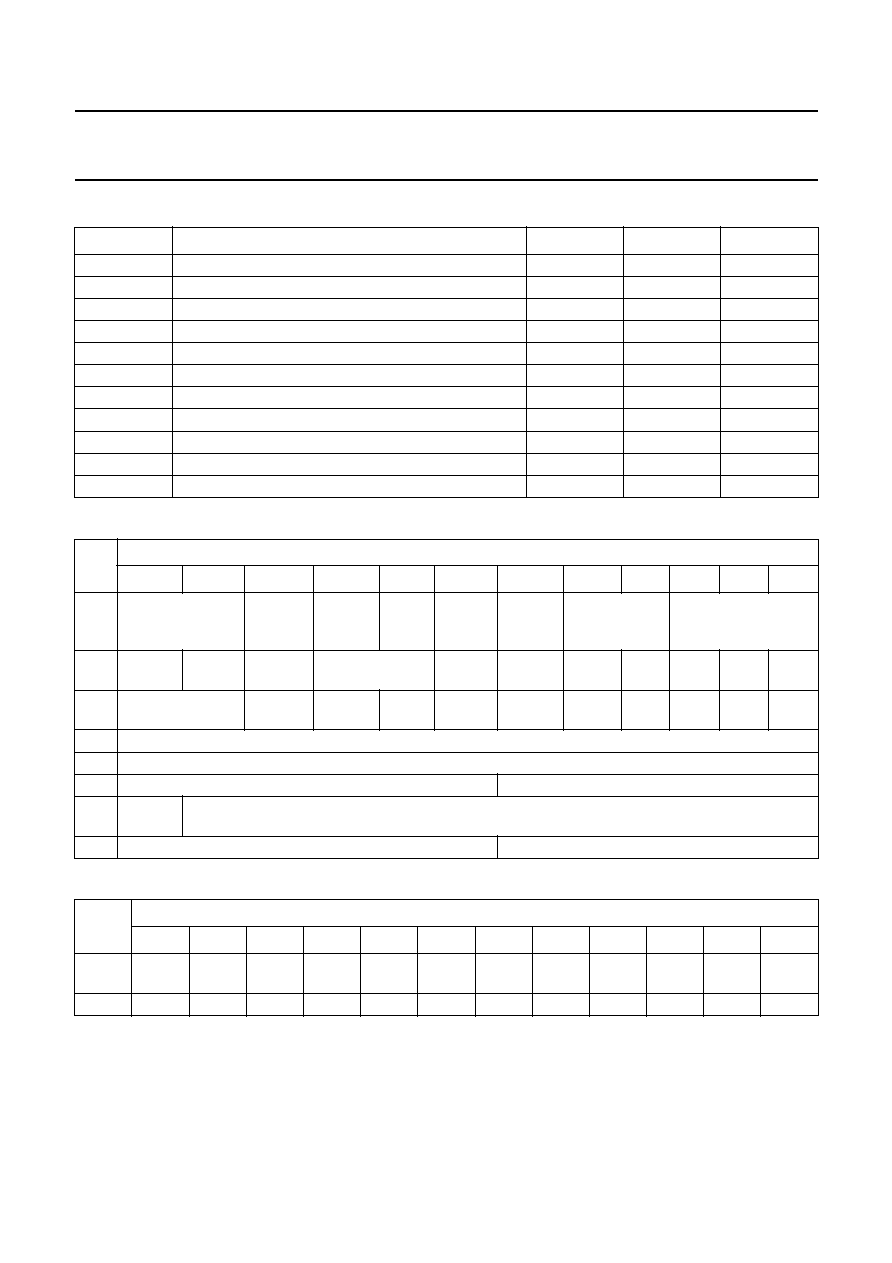
1998 Nov 02
14
Philips Semiconductors
Product specification
Disk drive spindle and VCM with
servo controller
OM5193H
Table 1
Timing information for the serial interface
Table 2
Writeable registers of the serial interface
Table 3
Readable registers of the serial interface
SYMBOL
PARAMETER
MIN.
MAX.
UNIT
f
clk
clock frequency
-
30
MHz
t
st
chip select to first active clock edge
1
/
2
T
clk
-
ns
t
su
data to clock set-up time
12
-
ns
t
hd
clock to data hold time
12
-
ns
t
rd
time data line is driven after 5th negative clock
-
5
ns
t
ren
time from positive clock for data line to be driven
0
-
ns
t
rhd
receive data hold time
0
-
ns
t
rsu
receive data set-up time
12
-
ns
t
exW
last active clock to chip select; inactive on write
0
-
ns
t
exR
last active clock to chip select; inactive on read
10
-
ns
T
bpa
time between successive serial port accesses
5
-
clock cycles
REG
BITS
11
10
9
8
7
6
5
4
3
2
1
0
0
not used
opamp
Select_N
increm.
Channel
auto
Conv.
select
range
Select
test
Mode_N
not used
ADC MUX address
1
reverse
break
not
used
seek/
trackfw
not used
sleep_N
spindiv
manual
run/
stop
comC comB
comA
2
not used
DAC
(9)
DAC
(8)
DAC
(7)
DAC
(6)
DAC
(5)
DAC
(4)
DAC
(3)
DAC
(2)
DAC
(1)
DAC
(0)
3
not used
4
not used
5
Watchdog
Blank 1
6
high
Clock_N
Comdelim
7
Start-up
Blank 2
REG
BITS
11
10
9
8
7
6
5
4
3
2
1
0
0
ADC
status
ADC
(9)
ADC
(8)
ADC
(7)
ADC
(6)
ADC
(5)
ADC
(4)
ADC
(3)
ADC
(2)
ADC
(1)
ADC
(0)
1
Ccross
Bcross
Across

1998 Nov 02
15
Philips Semiconductors
Product specification
Disk drive spindle and VCM with
servo controller
OM5193H
Table 4
Address of registers
R/W
A2
A1
A0
REG.
DESCRIPTION
0
0
0
0
0
ADC channel and programmable options
1
0
0
0
0
ADC status and value
0
0
0
1
1
commutation, sleep, and VCM switch controls
1
0
0
1
1
commutation state in manual mode
0
0
1
0
2
10-bit DAC
0
0
1
1
3
not used
0
1
0
0
4
not used
0
1
0
1
5
Blank 1 and Watchdog delays
0
1
1
0
6
commutation delay limit (11 bits), internal clock divider factor
0
1
1
1
7
Start-up and Blank 2 delays
8.2
Commutation and sleep mode
Spindle control and sleep mode are controlled by writing or
reading on register#1.
∑
Register#1 (0, 1 and 2) control the spindle
commutations in manual mode when run/stop, manual
and sleep bits are correctly set. The commutation
sequence is described in Section "Spindle driver" (see
also Table 16 and Fig.12).
∑
Register#1 (3) is the run/stop bit. After the power is
turned on and POR is HIGH, the motor will not start
spinning until register#1 (3) has been set to logic 1.
The motor stops spinning when this bit is set to logic 0.
∑
Register#1 (4) is the manual commutation mode bit.
When this bit is set to logic 1 and register#1 (3) set to
logic 1, the commutation logic in the OM5193H will be
disabled so that the spindle will not automatically go to
the next commutation.
When register#1 (3 and 4) are set to logic 1, the
microcontroller is expected to generate the different
commutation states for the motor. The OM5193H will
still provide the coil status which will be available by
reading register#1. The different waveforms are shown
in Section "Spindle driver" (see also Fig.12). Note that
depending on the coil status acquisition moment,
transient states (due to the flyback pulses) can be read.
When register#1 (4) is set to logic 0, the manual mode
is disabled and the OM5193H will automatically
commutate the motor each time a zero crossing is
detected. The time between the zero crossing and the
next commutation is half the time between the two
preceding zero crossings. This is explained in the
detailed description in Section "Commutation control".
∑
Register#1 (5) is the spindiv bit. This bit together with
register#6 (11) enables the selection of a divider factor
for both converter clock and spindle clock. Clock
configurations are described in Section "Commutation
control" (see also Table 6).
∑
Register#1 (6) is the sleep mode bit. When it is set to
logic 0, the OM5193H will enter the low power mode.
Then the commutation control generates (101) output
codes on commutation signals to set spindle and VCM
head into sleep mode. This causes the OM5193H to go
into the brake-after-park mode. The only operating
circuits are the power monitor, the voltage reference
generator, the VCM precharge circuit and the serial
interface. The OM5193H is in sleep mode when POR is
LOW.
When the power is first turned on, the POR signal goes
HIGH after the POR delay. The OM5193H is then
automatically set in sleep mode and thus in low power
consumption mode. The VCM DAC output is in
high-impedance mode, the spindle is in the brake mode
and the VCM is in the precharge mode. Only after POR
is HIGH and register#1 (6) is set to logic 1, OM5193H is
ready to be functional. When register#1 (6) goes HIGH,
the VCM DAC outputs the 2.5 V reference voltage.
∑
Register#1 (11) is dedicated to brake the spindle motor
without going in `brake-after-park' mode.
The commutation sequence is shifted in order to
efficiently brake the motor. This brake, called reverse
brake, is activated when register#1 (11) bit is set to
logic 1. Note that there is no action on the VCM input
signal when the reverse brake is used. When this bit is
set to logic 0, the spindle motor starts again with normal
spindle commutations.

1998 Nov 02
16
Philips Semiconductors
Product specification
Disk drive spindle and VCM with
servo controller
OM5193H
Reading register#1 will read the state of the 3 coils coming
from the spindle control block (ACROSS, BCROSS and
CCROSS). The 3 input lines will be in bits 0, 1, and 2.
The different waveforms are shown in Section "Spindle
driver" (see also Fig.12). Note that depending on the coil
status acquisition moment, transient states (due to the
flyback pulses) can be read.
Table 5
Writing register#1
BIT
DEFAULT
VALUE
NAME
DESCRIPTION
0
0
comA
drives COMA when in manual commutation
1
0
comB
drives COMB when in manual commutation
2
0
comC
drives COMC when in manual commutation
3
0
run/stop
0 = motor to brake-after-park mode
1 = motor spinning; VCM active
4
0
manual
0 = automatic commutation mode with run/stop = 1
1 = manual commutation mode with run/stop = 1
5
0
spindiv
0 = the internal spindle clock frequency is controlled by register#6 (11)
(bit highClock_N)
1 = an additional divider by 4 is added on the internal spindle clock
6
0
sleep_N
0 = sleep mode: low power mode, serial interface active, power stages in
brake-after-park mode
1 = fully functional mode: sleep_N has higher priority than run/stop if both are
active
7
0
-
not used
8
0
-
not used
9
1
seek/trackfw
0 = VCMIN connected to SEEKSELECT
1 = VCMIN connected to TRACKFWSELECT
10
1
-
not used
11
0
reverse break 1 = active brake control
0 = normal commutations as defined by bits above
8.3
Commutation control
The commutation logic block generates the six different
states to rotate the spindle motor. The spindle driver block
provides the BEMF zero crossing information.
The commutation block interprets the zero crossing
information and determines the commutation delay time
and the next coil state. The commutation block must take
into account the following situations:
∑
Start-up
∑
No start
∑
Reverse rotating
∑
Run
∑
Manual commutation.
The commutation logic keeps the motor spinning by
commutating the motor after each detected zero crossing.
It measures the time between two successive BEMF zero
crossings and then determines the next commutation.
The delay (commutation delay) between a zero crossing
and the next commutation is half the time between the two
preceding zero crossings. The commutation delay
(Comdelim) can be limited to guarantee a faster lock after
the motor has gone out of lock. A maximum commutation
delay can be set via the serial port. The time is a function
of both the external clock frequency, the individual register
prescalers and the time programmed into the registers.
Figure 7 shows a typical motor commutation timing
diagram.

1998 Nov 02
17
Philips Semiconductors
Product specification
Disk drive spindle and VCM with
servo controller
OM5193H
Fig.7 A typical motor commutation diagram.
handbook, full pagewidth
MGM978
centre tap
commutation
Blank 1
Zc1
Zc2
Zc3
flyback pulse
false zero crossings
true zero crossing
commutation
Commutation
delay
Blank 2
Start-up
Watchdog
∑
Blank 1
After a commutation occurs, the leading edge of the
flyback pulse has a zero crossing (Zc
1
). Blank 1 timer is
used to ignore this zero crossing by masking it while the
timer initialized at Blank 1 value is counting. The state
associated to Blank 1 down-counter will end when the
counter reaches the zero value.
∑
Blank 2
The Blank 2 timer starts counting as soon as the second
zero crossing occurs (Zc
2
). After the second flyback
pulse zero crossing, all extra zero crossings are ignored
during the Blank 2 time. This allows the ringing of the
coil voltage without causing a commutation advance.
The state associated to Blank 2 down-counter will end
when the counter reaches the zero value.
∑
Watchdog
The Watchdog timer makes sure the motor is running in
forward direction. If the motor is rotating in reverse
direction, the BEMF voltage is inverted and the second
crossing of the flyback pulse (Zc
2
) will not occur until the
true BEMF zero crossing is detected. Therefore, if the
Watchdog timer expires before a zero crossing occurs,
the motor is assumed to be rotating backwards.
The commutation is advanced by one step to correct
this condition. The Watchdog time must be set to a value
that is greater than the flyback pulse duration, measured
when the spindle motor stands still.
The state associated to the Watchdog timer will start
when the one associated to Blank 1 timer is finished and
will end when Zc
2
occurs or when the Watchdog counter
expires.
∑
Start-up
If the motor is not spinning, the BEMF zero crossings will
not occur. The Start-up timer detects this if it expires
before the true zero crossing (Zc
3
) has occurred. It will
advance the commutation by one step if this happens.
The state associated to Start-up timer will start when the
one associated to Blank 2 timer is finished and will end
when Zc
3
occurs or when Start-up expires.
∑
Comdelim
The timer associated to Comdelim value allows to
control the maximum commutation delay (between zero
crossing and next commutation). When the true zero
crossing is detected (Zc
3
), the timer will count until it
expires and then will commutate the motor to the next
step. This commutation delay time is equal to half the
measured value between 2 zero crossings.
The Comdelim value should be set to the maximum
allowable delay value. If
Zc
meas
is lower than the
programmed Comdelim value, the next timer value will
be
Zc
meas
divided by 2. If
Zc
meas
is higher than the
programmed Comdelim value, the next timer value will
be the programmed Comdelim value divided by 2.

1998 Nov 02
18
Philips Semiconductors
Product specification
Disk drive spindle and VCM with
servo controller
OM5193H
The clock used in the commutation logic block is obtained
by dividing the master clock of the chip (f
CLOCK
) by a clock
divider (Prescaler). This internal clock will be named
internalSpindleClock. Internal spindle clock configurations
are described in Table 6.
All the delays described above (Blank 1, Watchdog,
Blank 2, Start-up and Comdelim) are generated by one
down-counter (called TIMER 1), see Fig.8 and one
up-counter (called TIMER 2), see Fig.9. Each of them
uses internalSpindleClock signal.
Table 6
Spindle clock configurations
8.3.1
B
LANKS
, W
ATCHDOG AND
S
TART
-
UP DELAYS
An internal down-counter called TIMER 1 is used to generate Blank 1, Blank 2, Watchdog and Start-up delays. It loads
one of these programmed values and counts down till it reaches zero.
spindiv
REGISTER#1 (5)
highClock_N
REGISTER#6 (11)
internalSpindleClock
0
0
1
/
16
f
CLOCK
0
1
1
/
32
f
CLOCK
1
0
1
/
64
f
CLOCK
1
1
1
/
128
f
CLOCK
Fig.8 Down-counter TIMER 1.
handbook, full pagewidth
19
Start-up
Blank 1
Blank 2
Watchdog
18
15
14
13
12
11
10
17
16
9
8
5
4
3
2
1
0
7
6
MGL481
The actual delay time will be:
(1)
Value is the decimal representation of the binary code
programmed in one of the 6 bit registers.
(2)
Delay
value
step
◊
=
Step
2
LSB
internalSpindleClock
---------------------------------------------------------------
=
(3)
We have to subtract (2
LSB
-
1) to obtain maxValue
because all the bits from 0 to (LSB
-
1) are set internally to
zero by design.
maxValue
2
MSB
1
+
(
)
1
≠
2
LSB
1
≠
≠
internalSpindleClock
----------------------------------------------------------------------------
2
MSB
1
+
(
)
2
LSB
≠
internalSpindleClock
------------------------------------------------------
=
=

1998 Nov 02
19
Philips Semiconductors
Product specification
Disk drive spindle and VCM with
servo controller
OM5193H
Table 7
Delays used for TIMER 1
Table 8
Numerical application with f
CLOCK
= 30 MHz
Notes
1. The first zero crossing of the flyback should occur within this time.
2. The real zero crossing should not come within this time after the second zero crossing of the flyback pulse.
3. The time should be larger than the duration of the flyback pulse measured when the motor stands still.
4. The actual zero crossing should occur within this time after the Blank 2 time has expired.
8.3.2
C
OMDELIM DELAY
An internal up-counter called TIMER 2 is used to measure the time between two zero crossings and also to set the
maximum commutation delay through Comdelim delay.
DELAY
LSB
MSB
BITS
Blank 1
2
7
6
Blank 2
5
10
6
Watchdog
7
12
6
Start-up
14
19
6
DELAYS
internalSpindleClock
1
/
16
f
CLOCK
1
/
32
f
CLOCK
1
/
64
f
CLOCK
1
/
128
f
CLOCK
STEP
MAX.
STEP
MAX.
STEP
MAX.
STEP
MAX.
Blank 1; note 1
2.13
µ
s
134
µ
s
4.27
µ
s
269
µ
s
8.53
µ
s
538 ms
17.1
µ
s
1.08 ms
Blank 2; note 2
17.1
µ
s
1.08 ms
34.1
µ
s
2.15 ms
68.3
µ
s
4.30 ms
137
µ
s
8.60 ms
Watchdog; note 3
68.3
µ
s
4.30 ms
137
µ
s
8.60 ms
273
µ
s
17.2 ms
546
µ
s
34.4 ms
Start-up; note 4
8.74 ms
550 ms
17.5 ms
1.101 s
35 ms
2.202 s
70 ms
4.404 s
Fig.9 Up-counter TIMER 2.
handbook, full pagewidth
Comdelim
12
11
10
9
8
5
4
3
2
1
0
7
6
MGL482

1998 Nov 02
20
Philips Semiconductors
Product specification
Disk drive spindle and VCM with
servo controller
OM5193H
Comdelim is the maximum value that can be reached by TIMER 2. So, this is the maximum time between 2 zero
crossings (
Zc). The maximum commutation delay (Comdelim delay) is then half this value.
The actual delay will be:
(4)
(5)
Value is the decimal representation of the binary code programmed in the 11-bit register.
(6)
(7)
(we have to add this offset because bits 0 and 1 are set internally to logic 1 by design).
(8)
(9)
Table 9
Delay used for TIMER 2
Table 10 Numerical application with f
CLOCK
= 30 MHz
The commutation delay counter, which starts counting at a zero crossing, has two operating modes:
∑
In the adaptive mode, the next zero crossing is detected before the commutation delay counter has reached its
programmed value. In this mode, the next commutation will occur at the measured t
Zcross
divided by 2 after the last
zero crossing.
∑
In the forced mode, the next zero crossing is detected after the commutation delay counter reaches its programmed
value. In this mode, the counter is stopped and the commutation logic block waits until the next zero crossing occurs.
After it occurs, the next commutation will be forced at the programmed commutation delay divided by 2.
DELAY
LSB
MSB
BITS
Comdelim
2
12
11
DELAYS
CLOCKOUT/PRESCALER
1
/
16
f
CLOCK
1
/
32
f
CLOCK
1
/
64
f
CLOCK
1
/
128
f
CLOCK
STEP
(
µ
s)
OFFSET
(
µ
s)
MAX.
(ms)
STEP
(
µ
s)
OFFSET
(
µ
s)
MAX.
(ms)
STEP
(
µ
s)
OFFSET
(
µ
s)
MAX.
(ms)
STEP
(
µ
s)
OFFSET
(
µ
s)
MAX.
(ms)
Zc
2.13
1.6
4.37
4.27
3.2
8.74
8.53
6.4
17.48 17.1
12.8
35
Comdelim
delay
1.07
0.8
2.18
2.13
1.6
4.37
4.27
3.2
8.74
8.53
6.4
17.48
Zc
value
step
◊
Offset
+
=
ComdelimDelay
Zc
2
-----------
=
Step
2
LSB
internalSpindleClock
---------------------------------------------------------------
=
Offset
3
internalSpindleClock
---------------------------------------------------------------
=
maximum
Zc
2
MSB
1
+
(
)
1
≠
internalSpindleClock
---------------------------------------------------------------
=
maximumComdelimDelay
2
MSB
(
)
1
2
---
≠
internalSpindleClock
---------------------------------------------------------------
=

1998 Nov 02
21
Philips Semiconductors
Product specification
Disk drive spindle and VCM with
servo controller
OM5193H
8.4
10-bit ADC with 7 analog inputs
The ADC is a signed 10-bit converter which uses the
successive approximation conversion technique.
The overall accuracy is 2% absolute error not including
contribution of the reference voltage and guaranteed
monotonicity.
8.4.1
I
NPUT CHANNELS
7 analog input channels can be sampled and converted:
∑
Channel 0: conversion of the op-amp A2 output
∑
Channel 1: conversion of the op-amp A1 output
∑
Channel 2: conversion of the VCM sense amplifier
output
∑
Channel 3: conversion of an analog external signal
∑
Channel 4: conversion of the temperature
monitor + temperature shutdown signal
∑
Channel 5: conversion of an analog external signal
∑
Channel 6: conversion of an internal signal, controlling
analog supply voltage over two ranges.
Channels 0 and 1 can be used as external inputs by
deactivating the 2 stand-alone op-amps A1 and A2
(op-amps are put in sleep mode), that means by putting
register#0 (9) at logic 1.
The ADC does not include input filtering. If this is required
in the application then it must be implemented externally.
8.4.2
I
NPUT RANGES
Two analog input ranges are possible: either between
1.5 and 3.5 V or between 0 and 5 V. The input range is
selected with register#0 (6):
∑
Register#0 (6) = 0: means input analog value between
1.5 and 3.5 V
∑
Register#0 (6) = 1: means input analog value between
0 and 5 V.
Table 11 Input analog voltage and corresponding output code
BIT
MIN. OUTPUT = 200H
MIDDLE OUTPUT = 000H
MAX. OUTPUT = 1FFH
register#0 (6) = 0
minimum input value = 1.5 V
middle input value = 2.5 V
maximum input value = 3.5 V
register#0 (6) = 1
minimum input value = 0 V
middle input value = 2.5 V
maximum input value = 5 V
8.4.3
C
ONVERSION MODES
Three different conversion modes are possible depending
on the states of register#0 (7) and register#0 (8):
∑
Auto conversion and input channel auto incrementation
mode.
This mode is obtained with register#0 (7) = 1 and
register#0 (8) = 1. The conversion sequence works as
follows: the first A/D conversion is started by writing to
serial port register#0. The address of the channel is
decoded from the three LSBs in register#0 [2 to 0].
Then the OM5193H selects the addressed analog
channel, samples and holds the analog input and starts
the analog to digital conversion. The conversion result is
obtained by reading the serial port register#0.
Register#0 (10) provides the status of the conversion: it
is set to 0 as long as the conversion is running and
indicates that the low 10 bits of register#0 are invalid.
Register#0 (10) going HIGH means the conversion is
complete and guarantees the validity of the data in
register#0 [9 to 0].
∑
Auto conversion on the same channel.
This input channel automatic incrementation option can
be deactivated by setting register#0 (8) to logic 0 with
register#0 (7) at logic 1. So the behaviour of the ADC is
the same as explained above, except that all the
conversions are made on the channel specified by the
last write access on register#0.
∑
Single conversion mode.
The automatic conversion mode can also be
deactivated by setting register#0 (7) to logic 0. In this
mode, a write access on register#0 will start a
conversion on the specified channel and a read access
will not launch any other conversion.

1998 Nov 02
22
Philips Semiconductors
Product specification
Disk drive spindle and VCM with
servo controller
OM5193H
8.4.4
P
ROGRAMMING REGISTER
#0
Table 12 Writing register#0
Note
1. Possible addresses:
a) ADC MUX address = 000: channel 0 selected;
b) ADC MUX address = 001: channel 1 selected;
c) ADC MUX address = 010: channel 2 selected;
d) ADC MUX address = 011: channel 3 selected;
e) ADC MUX address = 100: channel 4 selected;
f) ADC MUX address = 101: channel 5 selected;
g) ADC MUX address = 110: channel 6 selected;
h) ADC MUX address = 111 is an illegal address. No analog input will be selected if a conversion is asked in this
channel and the ADC will convert a random analog value.
For a correct initialization of the converter just after power up, when POR is HIGH (before using the ADC or the DAC),
the register#0 has to be programmed as follows: write 020H and then write 000H. A read of register#0 between the
2 write accesses is not necessary.
BIT
DEFAULT VALUES
NAME
DESCRIPTION
0
ADC MUX address; note 1 ADC MUX address 0
1
ADC MUX address 1
2
ADC MUX address 2
3
not used
4
not used
should be at logic 0 under normal operating
conditions
5
0
testMode_N
dedicated for test purposes of the DAC in ADC or
DAC mode; should be at logic 0 under normal
operating conditions
6
0
rangeSelect
selects the analog input range of the ADC:
0 = range 1.5 to 3.5 V
1 = range 0 to 5 V
7
0
autoConvSelect
selects the automatic conversion option; see details
in Table 13
8
0
incrementChannel
selects the automatic channel increment option; see
details in Table 13
9
0
opampSelect_N
selects the stand-alone op-amps:
0 = op-amps activated
1 = op-amps deactivated
10
not used
11
not used
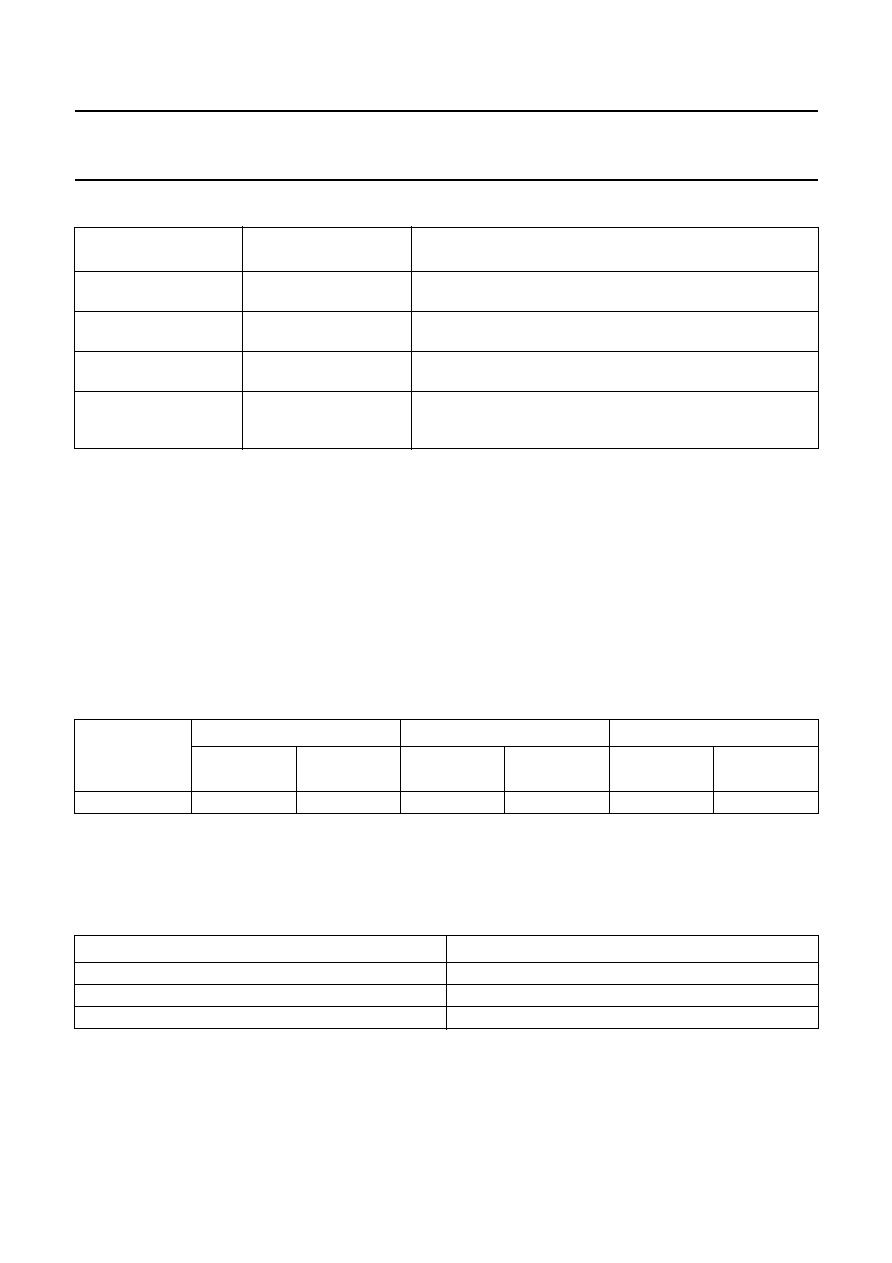
1998 Nov 02
23
Philips Semiconductors
Product specification
Disk drive spindle and VCM with
servo controller
OM5193H
Table 13 Truth table for bits 7 and 8 on register#0 in write mode; conversion mode options; note 1
Note
1. The autoConvSelect bit has priority over the incrementChannel bit.
8.4.5
C
ONVERTER CLOCK FREQUENCY VALUES
The ADC internal clock named converterClock can have two different frequency values by programming register#6 (11)
(bit highClock_N):
Register#6 (11) = 1: means converterClock = Master clock (f
CLOCK
) divided by 8 (clockDivider = 8)
Register#6 (11) = 0: means converterClock = Master clock (f
CLOCK
) divided by 4 (clockDivider = 4)
(10)
Table 14 Numerical application
8.5
10-bit VCM DAC
The VCM DAC is a signed 10-bit digital-to-analog convertor. It will start the conversion when register#2 is written.
The lowest 10 bits contain the value to be converted.
Table 15 Input code and corresponding output analog voltage
The overall accuracy is 2% absolute error not including the contribution of the reference voltage and guaranteed
monotonicity.
autoConvSelect
REGISTER#0 (7)
incrementChannel
REGISTER#0 (8)
DESCRIPTION
0
0
Default state: no auto channel incrementation, no A/D
conversion started automatically after each read of the result.
1
0
Starts automatically an A/D conversion on the same channel
(no channel incrementation) after each read of the result.
1
1
Starts automatically an A/D conversion on the next channel
(increment the channel by 1) after each read of the result.
0
1
No auto channel incrementation, no A/D conversion started
automatically after each read of the result (similar to the default
state `00').
TIME
MASTER CLOCK = 10 MHz
MASTER CLOCK = 20 MHz
MASTER CLOCK = 30 MHz
DIVISION
BY 8
DIVISION
BY 4
DIVISION
BY 8
DIVISION
BY 4
DIVISION
BY 8
DIVISION
BY 4
Conversion time
10.4
µ
s
5.2
µ
s
5.2
µ
s
2.6
µ
s
3.4
µ
s
1.7
µ
s
INPUT CODE
OUTPUT VOLTAGE
200H
1.5 V
000H
2.5 V
1FFH
3.5 V
conversionTime
13
clockDivider
◊
f
CLOCK
---------------------------------------------
=

1998 Nov 02
24
Philips Semiconductors
Product specification
Disk drive spindle and VCM with
servo controller
OM5193H
8.6
Reference voltage
V
ref2V5
is a 2.5 V bandgap reference used as the reference
voltage for the VCM circuit. Stable voltages of
1.5 and 3.5 V are generated from the 2.5 V reference and
used as reference voltages for the VCM DAC and for the
ADC. The 1.5 and 3.5 V voltages are only available inside
the IC and are not connected to external pins.
8.7
Stand-alone op-amps
This block is composed of two low-offset stand-alone
op-amps (A1 and A2) with outputs connected to the ADC
channels 0 and 1.
The stand-alone op-amps can be deactivated if they are
not used in the application. When deactivated, they are put
in sleep mode and outputs are in high-impedance. In that
case, ADC channels 0 and 1 can be used as input signals.
The op-amps are controlled by writing to the serial port on
register#0 (9); bit opampSelect_N:
Register#0 (9) = 0: means the op-amps are selected
and put in normal mode
Register#0 (9) = 1: means the op-amps are not selected
and put in sleep mode.
8.8
Analog switch
This block is composed of a 2 input analog multiplexer
used to select the seek mode or the track-following mode.
It is controlled by writing to serial port register#1 (9);
bit seek/trackfw:
Register#1 (9) = 0: means input SEEKSELECT is
selected and connected to VCMIN
Register#1 (9) = 1: means input TRACKFWSELECT is
selected and connected to VCMIN.
8.9
Charge pump voltage
The charge pump voltage circuit (voltage doubler)
generates a power supply voltage higher than V
DDA2
(12 V) power supply. This voltage is used to:
∑
Drive the upper N-channel FETs of the power stages
∑
Drive an optional external FET (see Section 8.18)
∑
Set a voltage independent of the power supply and
temperature for the functions BRAKEPOWER and
BRAKEDELAY.
Two external capacitors are used to generate the higher
voltage on pin CAPY. The capacitor between
BSTCP1 and BSTCP2 is charged and discharged with a
frequency, which is a function of the charge pump output
current and an internal oscillator frequency. The voltage
on pin CAPY is typically 19.2 V. Figure 10 illustrates the
charge pump block diagram.
Fig.10 Charge pump voltage generator.
handbook, full pagewidth
MGM979
COMPARATOR
OSCILLATOR
200 kHz
reference
BSTCP1
BSTCP2
CAPY
GNDS
CCAPX
CCAPY
VDDA2

1998 Nov 02
25
Philips Semiconductors
Product specification
Disk drive spindle and VCM with
servo controller
OM5193H
8.10
Spindle driver
The spindle block contains both the low-side and high-side
drivers configured as a H-bridge for a 3-phase DC
brushless, sensorless motor. In each of the six possible
states, two outputs are active, one sourcing current and
one sinking current. The third output presents a high
impedance to the motor which enables measurement of
the BEMF in the corresponding motor coil. The BEMF zero
crossing comparator outputs (xCROSS) are processed by
the commutation logic circuit to calculate the correct
moment for the next commutation, so the change to the
next output state. The commutation logic circuit provides
proper commutation commands for the spindle drivers
thus ensuring the rotation of the motor. The commutation
logic circuit also controls the spindle motor driver during
start-up (no reverse rotation).
The spindle should be set in the high-impedance mode
(see Table 16) between the sleep mode (brake-after-park
mode) and the normal running mode. Register#1 should
be programmed as follows:
∑
Write 00x001x11010 to activate the manual mode
during typically less than 1 ms (time discharge of
low-side power FETs)
∑
Write 00x001x01xxx to activate the automatic running
mode. The `x' states concern the seek or track-following
mode register#1 (9) and the spindle prescaler value
used on the application register#1 (5). Their states are
specific to the application needs.
The ZCROSS signal is a combination of the xCROSS
signals. It can be used by the microcontroller as a tacho
information for the spindle speed control loop.
The external SPCC signal is used to control the spindle
current. The external SPCCOUT capacitor is connected to
the spindle current control amplifier to ensure the stability
of the spindle current control loop.
The short-circuit brake mode is entered if power-down,
thermal shutdown or sleep mode occurs.
A Miller network is used to obtain soft switching on the
low-side and high-side drivers.
The slew rate of the driver stage that is switched-off can be
controlled by means of a resistor connected to the pins
SLEW and GND. The slew rate is calculated using the
following equation:
(11)
SR
3
µ
A
2.55
4
1 k
R
SLEW
+
(
)
◊
-------------------------------------------------------
+
20 pF
---------------------------------------------------------------------------
=
R
SLEW
is in
and SR in V/s. Without a resistor, SR is
typical 0.15 V/
µ
s and with a resistor of 90 k
, the typical
value is 0.5 V/
µ
s. The maximum slew rate depends on the
limit for stability of the spindle loop.
The spindle current I
SPRUN
is sensed by an external
resistor R
SPSENSE
connected to a sense amplifier
providing the internal signal SPOUT. The gain G
v
of the
sense amplifier is typical 10.
(12)
The transconductance gain of the spindle loop is given by
the following equation:
(13)
The control amplifier differentiates the control signal on
pin SPCC from the signal SPOUT. A 0.25 V offset is
subtracted from the input voltage on pin SPCC to ensure
that the current command includes the zero current. With
the spindle loop closed, the voltage SPOUT is given by the
following equation:
(14)
The control signal V
CONTROL
provided by the control
amplifier is then applied to the spindle drivers. The spindle
drivers control the voltage on the gate of the low-side
power drivers. One of the three high-side drivers is fully on.
The charge pump voltage is applied to the gate. One of the
three low-side drivers is controlled by the control amplifier.
Purpose is to adjust the voltage on the gate to adjust the
total output resistance R
ds(on)
at the specified running
current.
The current in the spindle loop is given by the following
formula:
(15)
With R
SPSENSE
= 0.25
:
(16)
The maximum start-up current is I
SPRUN
= 1.9 A with
SPCC signal at 5 V.
Figure 11 illustrates the spindle current control loop.
V
SPOUT
G
v
R
SPSENSE
I
SPRUN
◊
◊
G
v
V
SPSENSEH
◊
=
=
g
s
I
SPRUN
V
SPOUT
---------------------
1
R
SPSENSE
---------------------------
V
SPSENSEH
V
SPOUT
-------------------------------
◊
1
R
SPSENSE
G
v
◊
-----------------------------------------
=
=
=
V
SPOUT
V
SPCC
V
OFFSET
≠
=
I
SPRUN
g
s
V
SPCC
V
OFFSET
≠
(
)
◊
=
I
SPRUN
0.4
V
SPCC
0.25
≠
(
)
◊
=
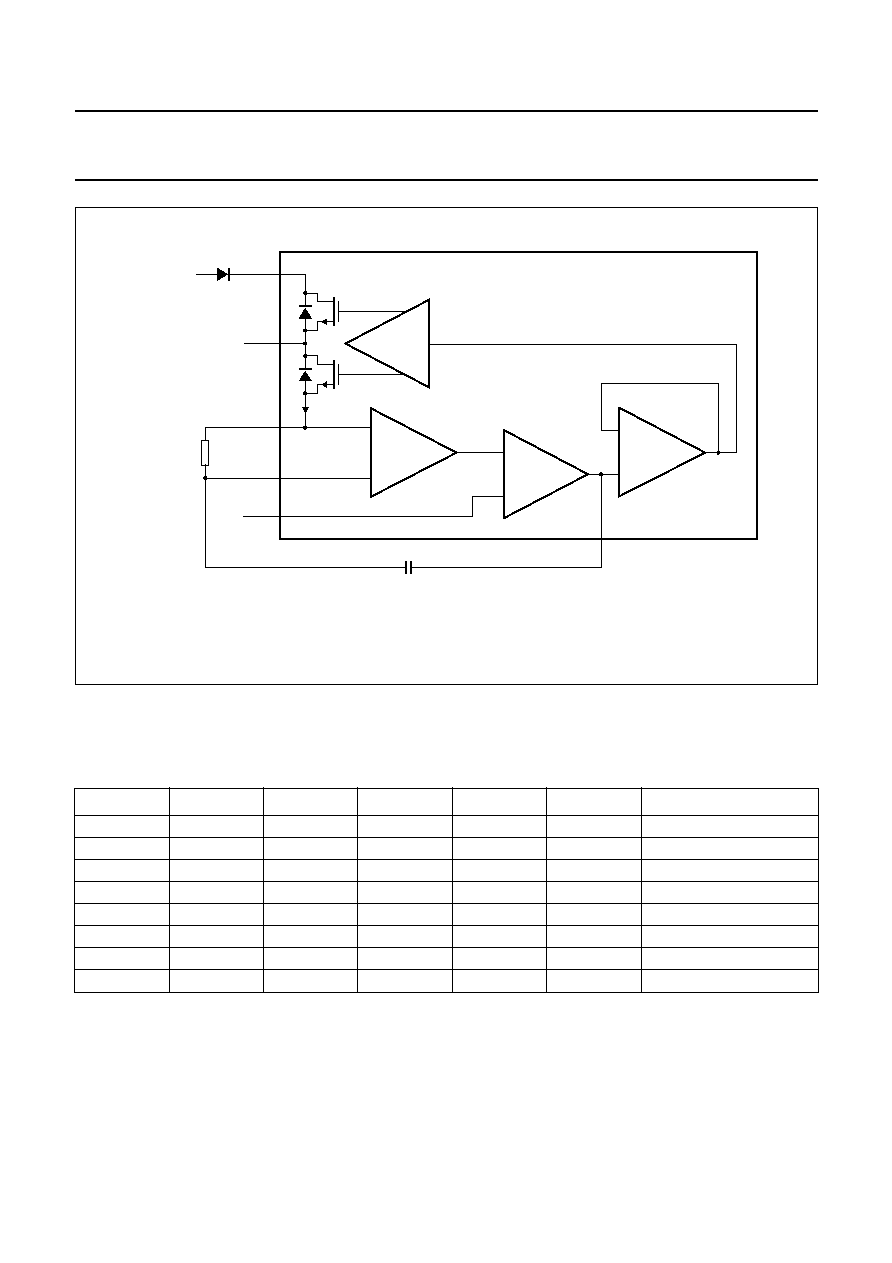
1998 Nov 02
26
Philips Semiconductors
Product specification
Disk drive spindle and VCM with
servo controller
OM5193H
Table 16 and Fig.12 illustrate the relationship between the commutation signals and the associated output drivers and
output comparators.
Table 16 Input commutations to output drivers
Note
1. F_L is for float-and-then-LOW (brake-after-park mode).
COMA
COMB
COMC
MOTA
MOTB
MOTC
STATE
0
0
0
LOW
HIGH
float
1
1
0
0
LOW
float
HIGH
2
1
1
0
float
LOW
HIGH
3
1
1
1
HIGH
LOW
float
4
0
1
1
HIGH
float
LOW
5
0
0
1
float
HIGH
LOW
6
1
0
1
F_L
(1)
F_L
(1)
F_L
(1)
SLEEP
0
1
0
float
float
float
Spindle high-impedance
Fig.11 Spindle transconductance loop schematic.
handbook, full pagewidth
SENSE
AMPLIFIER
CONTROL
AMPLIFIER
PRE-
DRIVER
SPOUT
GNDS/
SPSENSEL
MOTSENSE/
SPSENSEH
VUPPER
VCONTROL
VLOWER
ISPRUN
external
diode
CLAMP
SPCC
CSPCCOUT
SPCCOUT
VDDA2POWER
MOTx
RSPSENSE
MGM980
0.25 V
OFFSET
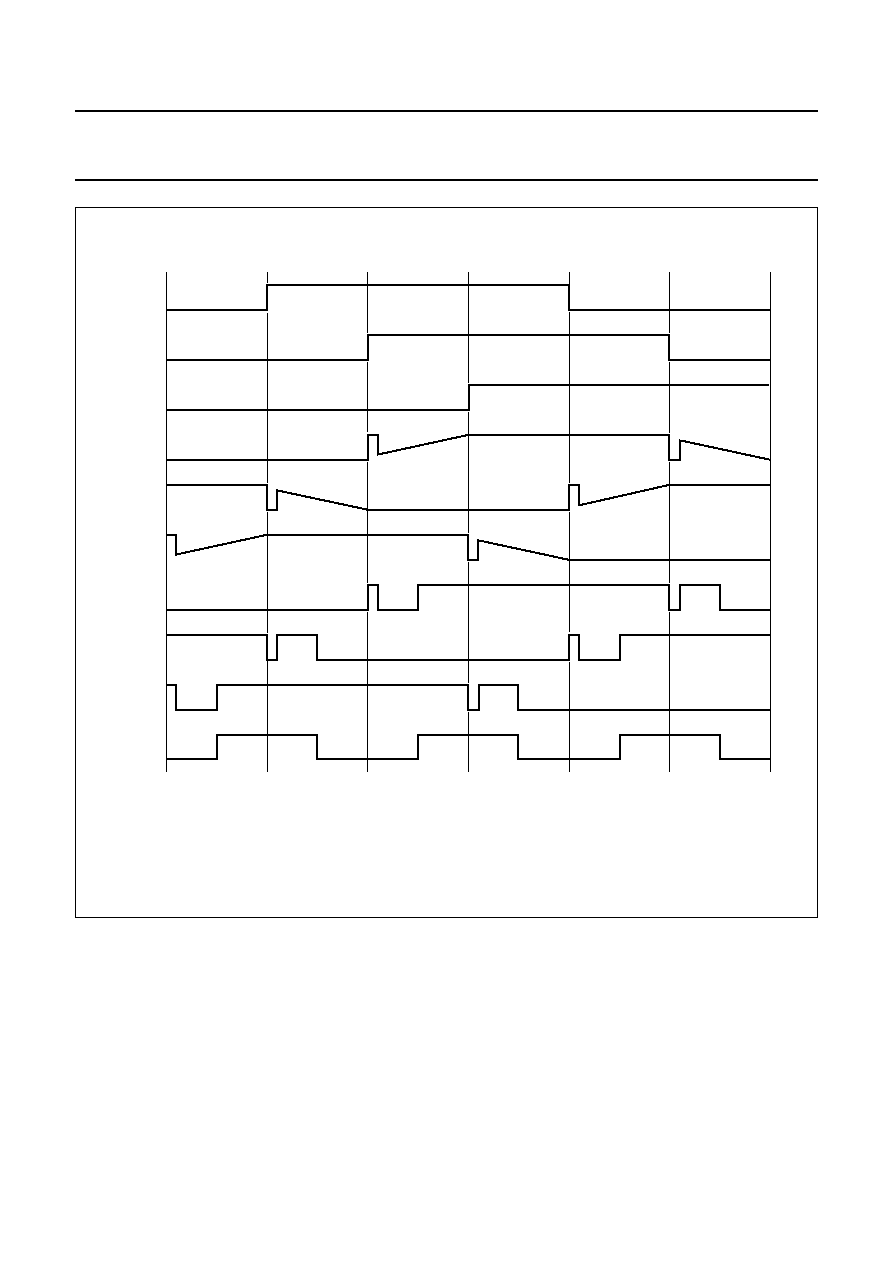
1998 Nov 02
27
Philips Semiconductors
Product specification
Disk drive spindle and VCM with
servo controller
OM5193H
8.11
VCM driver
The VCM driver is a linear, class AB amplifier with both low-side and high-side drivers configured as an H-bridge.
The zero-current reference voltage for the VCM loop is internally set at 2.5 V. The sense resistor R
VCMSENSE
enables the
VCM current (I
VCMRUN
) to be measured through the sense amplifier. The gain G
v
of the sense amplifier is typically 4.
The output voltage (V
sout
) on pin ADC[2]/SOUT is given by the following equation:
(17)
Figure 13 presents the VCM sense amplifier.
Fig.12 Input commutations to output drivers.
handbook, full pagewidth
MGM981
COMA
0
1
1
1
0
0
0
0
1
1
1
0
0
0
0
1
1
1
L
L
F
H
H
F
H
F
L
L
F
H
F
H
H
F
L
L
COMB
COMC
MOTA
MOTB
MOTC
ACROSS
BCROSS
CCROSS
ZCROSS
L = LOW.
H = HIGH.
F = Floating.
V
sout
G
v
R
VCMSENSE
I
VCMRUN
V
ref2V5
G
v
V
VCMSENSEH
V
VCMSENSEL
≠
(
)
V
ref2V5
+
◊
=
+
◊
◊
=

1998 Nov 02
28
Philips Semiconductors
Product specification
Disk drive spindle and VCM with
servo controller
OM5193H
The error amplifier (see Fig.14) compares the DACOUT input command and the output signal V
sout
of the sense amplifier
to generate the control voltage of the power drivers.
(18)
Finally, the transconductance gain of the VCM loop is given by the following equation:
(19)
Fig.13 VCM sense amplifier.
handbook, full pagewidth
MGM982
IVCMRUN
R
R
4R
VCMSENSEH
RVCMSENSE
VCMSENSEL
NIVCM
REF2V5
4R
ADC[2]/SOUT
V
ref2V5
V
DACOUT
≠
R
i
--------------------------------------------------
V
sout
V
ref2V5
≠
R
o
---------------------------------------
G
v
R
VCMSENSE
I
VCMRUN
◊
◊
R
o
---------------------------------------------------------------------------
=
=
Fig.14 VCM transconductance gain schematic.
handbook, full pagewidth
MGM983
SENSE
AMPLIFIER
Ga
ERROR
AMPLIFIER
IVCMRUN
Ro
Ri
VCMSENSEH
RVCMSENSE
VCMSENSEL
NIVCM
REF2V5
to power
drivers
VCMIN
DACOUT
ADC[2]/SOUT
g
v
I
VCMRUN
V
ref2V5
V
DACOUT
≠
--------------------------------------------------
R
o
R
i
-------
1
G
v
R
VCMSENSE
◊
---------------------------------------------
◊
=
=

1998 Nov 02
29
Philips Semiconductors
Product specification
Disk drive spindle and VCM with
servo controller
OM5193H
The VCM loop gain is set through external resistors. The seek (high gain) or the track-following (low gain) mode is
controlled with the serial bus. Purpose is to set the appropriate gain by selecting the R
i
resistor through the low
impedance analog 2 input switch.
Fig.15 VCM selectable loop gain.
handbook, full pagewidth
VCM DAC
VCM switch
to VCM
drivers
MGM984
VCMIN
Ro
(1)
(2)
SEEKSELECT
TRACKFWSELECT
Ri(TRACKFW)
Ri(SEEK)
DACOUT
ADC[2]/SOUT
(1) High gain.
(2) Low gain.
8.12
Park the VCM
A VCM park sequence is initiated any time a power-down,
a thermal shutdown and/or a sleep mode situation occurs.
The fault signal (FAULT) initiates the VCM park sequence.
This secure function is accomplished even in case of
power loss. In this case, the energy provided by the
rectified BEMF of the spindle motor coils is used to supply
the park circuit and park the heads above a landing area.
Otherwise, the energy is provided by the V
DDA2
power
supply through an external diode or power FET.
To accomplish this function, the spindle power stage is
automatically set in a high-impedance mode. The NIVCM
low-side power driver is fully on while the remaining power
drivers of the VCM power stage are off.
The current flowing in the PARKVOLT resistor sets the
voltage on the PARKVOLT pin. The voltage across the
VCM load is internally regulated by the voltage on the
PARKVOLT pin. An internal circuit clamps the voltage on
PARKVOLT at 3V
BE
. Without resistor, the voltage on
PARKVOLT is 3V
BE
. The park current I
coilpark
is applied to
the VCM coil. The I
coilpark
park current is given by the
following equation:
(20)
I
coilpark
V
PARKVOLT
R
VCMSENSE
R
coil
R
ds on
(
)
k
sin
(
)
+
+
-------------------------------------------------------------------------------------------
=
An RC network is connected to pin BRAKEDELAY. During
the normal functioning, the voltage on the BRAKEDELAY
pin is typically V
BDC
= 12.55 V. This value is independent
of the power supply and the temperature. During park
mode, the RC network discharges with a time constant
.
The park mode is activated as long as the voltage on the
BRAKEDELAY pin is greater than the internal brake delay
threshold voltage V
BDT
of typically 2.2 V.
The t
BDT
park time duration (or brake delay time duration)
is set by the following equation:
(21)
where
(22)
C
BRAKED
and R
BRAKED
are respectively the capacitor and
the resistor connected to the BRAKEDELAY pin.
Typically, with C
BRAKED
= 330 nF and R
BRAKED
= 650 k
,
t
BDT
= 400 ms.
Figure 16 shows the equivalent park circuit.
t
BDT
In
V
BDC
V
BDT
-------------
◊
=
C
BRAKED
R
BRAKED
◊
=

1998 Nov 02
30
Philips Semiconductors
Product specification
Disk drive spindle and VCM with
servo controller
OM5193H
Fig.16 Park circuit.
handbook, full pagewidth
MGM985
external
diode
ACTUATOR
RCOIL
FAULT
NIVCM
IVCM
GNDVCM
GNDV
RPARKVOLT
PARKVOLT
CLAMP
CCLAMP
VDDA2POWER
RVCMSENSE
Icoilpark
8.13
Precharge the VCM
When the voltage on the BRAKEDELAY pin goes below
the brake delay threshold voltage V
BDT
, the
BRAKEDELAY pin is short-circuited to ground. While the
brake mode is activated, the VCM outputs are precharged
to V
DDA1
-
V
BE
while pin VCMIN is short-circuited to
ground.
This function precharges the external RC compensation
network.
The NIVCM low-side power driver is set off during VCM
precharge. This is convenient for actuators with a
magnetic latch.
The park circuit is powered off during VCM precharge with
the actuator latched.

1998 Nov 02
31
Philips Semiconductors
Product specification
Disk drive spindle and VCM with
servo controller
OM5193H
Fig.17 Precharge circuit.
handbook, full pagewidth
MGM986
external diode
ACTUATOR
GND
BRAKEDELAY
GND
GND
NIVCM
IVCM
GNDVCM
GNDV
CLAMP
VCMIN
VDDA1
VDDA2POWER
RVCMSENSE
8.14
Brake the motor
A spindle brake sequence is initiated any time a
power-down, a thermal shutdown and/or a sleep mode
situation occurs. The fault signal activates the
brake-after-park sequence.
When the heads are parked, the motor has to be braked in
order to guarantee heads reliability. During the brake
sequence, the heads land on a dedicated area of the disk.
The OM5193H integrates a highly efficient, low cost brake
circuit. It is guaranteed to be functional in case of power
loss and thermal shutdown with a short time brake duration
thus minimizing friction of the heads on the landing zone.
The energy stored by an external capacitor connected to
the BRAKEPOWER pin supplies the brake circuit during
the brake-after-park sequence.
The brake of the motor is accomplished by turning on the
spindle low-side power components while high-side power
drivers are off. This causes a short-circuit of the spindle
motor coils and thus reversing the current and torque of
the motor.
During normal operation, the voltage V
BDC
on the
BRAKEPOWER pin is typically V
BDC
= 12.55 V. This value
is independent of the power supply and the temperature.
During the park sequence, the discharge of the
BRAKEPOWER capacitor is set by an internal resistor,
with or without an optional external resistor between
BRAKEPOWER and BRAKEADJUST. The typical value of
the internal resistor is 4 M
.
The brake sequence is started when the voltage on
BRAKEDELAY goes below the brake delay threshold
voltage V
BDT
of 2.2 V. The gates of the three spindle
low-side power drivers are charged by the energy stored in
the BRAKEPOWER capacitor and thus braking the motor.
The OM5193H will stay in the brake-after-park mode until
register#1 (3) bit run/stop is set to logic 1.

1998 Nov 02
32
Philips Semiconductors
Product specification
Disk drive spindle and VCM with
servo controller
OM5193H
Fig.18 Brake circuit.
handbook, full pagewidth
CBRAKEP
RBRAKEP
(optional)
BRAKEDELAY
GNDV
GNDS/SPSENSEL
MOTSENSE/
SPSENSEH
GND
BRAKEADJH
BRAKEPOWER
CBRAKED
power-down
external
diode
CLAMP
VDDA2POWER
MOTx
RBRAKED
RSPSENSE
MGM987
The typical value for the BRAKEPOWER capacitor is 1
µ
F.
An optional resistance could be added between the
BRAKEPOWER and BRAKEADJUST pins. The values of
the capacitor and the resistor are depending on the
application.
Without resistor, the BRAKEADJH pin must be connected
to the BRAKEPOWER pin.
8.15
Power-on reset
The Power-On Reset (POR) circuit monitors the voltage
level of both 5 and 12 V supply voltages as shown in
Fig.19.
The POR active LOW logic line is set HIGH following the
5 and 12 V supply voltage rise above a specified voltage
threshold plus a hysteresis, and delayed by a time t
C
that
is determined by the external CPOR capacitor.
This POR output remains HIGH until either the 5 or 12 V
supplies drop below their voltage threshold, at which point
the POR output becomes LOW.
The C
CPOR
capacitor is charged with a typically 2.7
µ
A
current. The voltage on CPOR is compared to the POR
circuit voltage reference of 2.55 V. The t
C
time is set by the
following equation:
(23)
where V
PORREF
= 2.55 V and I
CPOR
= 2.5
µ
A typically.
The value of the t
C
time is set by the C
CPOR
capacitor
value.
t
C
C
CPOR
V
PORREF
◊
I
CPOR
------------------------------------------------
=
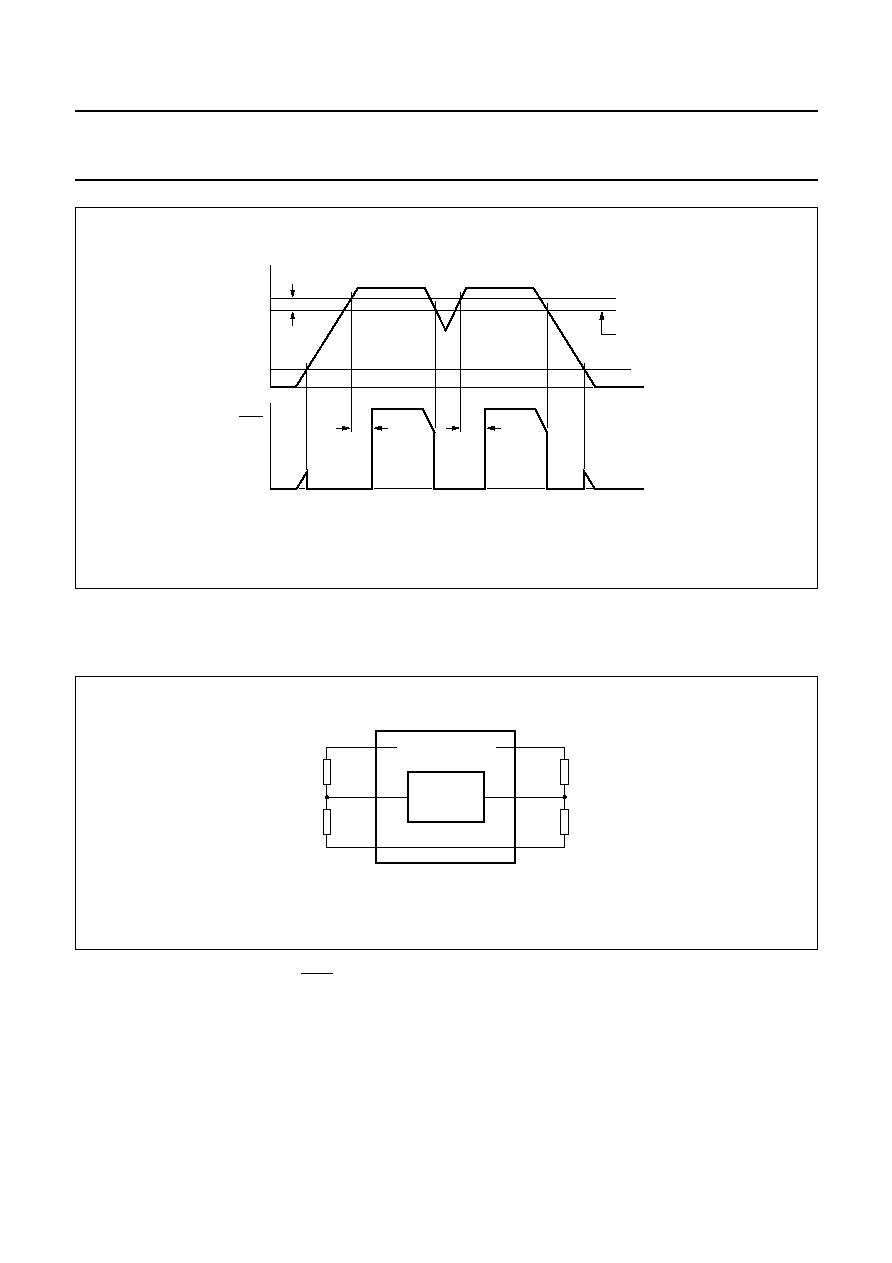
1998 Nov 02
33
Philips Semiconductors
Product specification
Disk drive spindle and VCM with
servo controller
OM5193H
The values of the 5 and 12 V supply threshold voltages can be adjusted by adding external bridge resistors respectively
on the CHK5 and CHK12 pins. Internally, the CHK5 and CHK12 pins are designed as described in Fig.20.
A glitch monitor prevents premature POR signals due to voltage spikes on power supplies. An external capacitor has to
be connected to the CHK5 and CHK12 pins to filter the noise on CHK5 and CHK12 pins caused by spikes on the power
supplies; see Fig.21.
Fig.19 Power-on reset timing.
handbook, full pagewidth
MGM988
threshold
POR
VDD
0.8 V
Vhys
t
t
tC
tC
Fig.20 CHK5 and CHK12 pins.
handbook, halfpage
MGM989
POWER-ON
RESET
RH12
RL12
CHK12
RH5
RL5
CHK5
VDDA1
VDDA2
GNDS

1998 Nov 02
34
Philips Semiconductors
Product specification
Disk drive spindle and VCM with
servo controller
OM5193H
Fig.21 Glitch detector timing.
handbook, full pagewidth
MGM990
minimum pulse
time = 10
µ
s
Vref
VDD
POR
CHK signal
(with capacitor)
t
t
t
V
tC
During a power-down situation, the POR circuit must not
only generate an output POR signal, but must also activate
the brake-after-park sequence. In doing so, the VCM
driver draws power from the BEMF of the motor coils
through the clamp line during spin-down, and uses this
power to bias the VCM against one of the hard stops of the
actuator. This prevents the heads from landing on data
zones.
POR also controls the digital part of the chip.
When POR is LOW, the chip is automatically set in the
brake-after-park mode.
When POR goes HIGH, the digital section is initialized
forcing the brake-after-park sequence until a normal start
is asked (by writing on register#1).
POR is considered as an asynchronous signal for the
digital part and default values are loaded when POR goes
HIGH. Default values for register#0 and register#1 are
shown in Section "Commutation and sleep mode" (see
also Table 5) and in Section "10-bit ADC with 7 analog
inputs" (see also Table 12).
If default values have to be loaded when POR is LOW, at
least one clock pulse is needed to load the registers with
default values.

1998 Nov 02
35
Philips Semiconductors
Product specification
Disk drive spindle and VCM with
servo controller
OM5193H
Fig.22 Initialization of the registers when POR is LOW.
handbook, full pagewidth
MGM991
POR circuit controls the
brake-after-park mode
commutation logic controls the
brake-after-park mode until a
spindle start is asked.
CLOCK
If there is a CLOCK signal when POR signal is LOW,
default register values will be loaded on the rising edge.
POR
default values are automatically
loaded when POR goes
HIGH if there is no CLOCK
during LOW state.
8.16
Thermal monitor and shutdown
The OM5193H is provided with both a temperature
monitor and a thermal shutdown circuit.
The device is protected against over-temperature by the
thermal shutdown circuit. When the temperature of the
chip exceeds 150
∞
C, the device is automatically set to the
brake-after-park mode. Furthermore, the voltage V
temp
on
pin ADC[4]/TEMP goes HIGH. It remains in this mode until
the temperature goes below the thermal shutdown
temperature minus typically 10
∞
C.
During the normal operation, the signal V
temp
provides a
voltage as a function of the chip temperature.
The equation of the voltage versus the temperature is the
following:
(24)
Figure 23 presents the voltage V
temp
on pin ADC[4]/TEMP
during normal operation and the voltage on thermal
shutdown with hysteresis.
V
temp
7.05
10
3
≠
◊
T
j
∞
C
(
)
◊
1.995
+
=
Fig.23 V
temp
behaviour versus temperature.
handbook, full pagewidth
Tj (
∞
C)
Vtemp
(V)
VDDA1
3.052
2.982
1.995
0
140
150
MGM992

1998 Nov 02
36
Philips Semiconductors
Product specification
Disk drive spindle and VCM with
servo controller
OM5193H
The pin ADC[4]/TEMP is internally connected to channel 4
of the ADC. The data can be read and processed by the
microcontroller to control the temperature of the device
during the spindle start-up sequence and normal operation
and to create an early high-temperature warning.
8.17
Power supply isolation
In case of power-down, the brake-after-park sequence
must be supplied from the motor BEMF and the energy
stored in the CLAMP capacitor. When the supply voltage
for the spindle and the VCM is directly connected to the
V
DDA2
, the energy from the motor BEMF and the CLAMP
capacitor will be lost in the V supply system instead that it
is used for brake-after-park sequence. Therefore, the
motor and VCM supply must be isolated from the V
DDA2
.
This can be done by means of a diode or a power FET
between V
DDA2
and the power supply line for the spindle
and the VCM.
8.17.1
E
XTERNAL ISOLATION DIODE
A diode can be used when the motor current and the VCM
current are low and the voltage drop over the diode does
not limit the supply voltage range of the motor and the
VCM. The diode can be either a normal diode or a
Schottky diode. The type and electrical properties of the
diode are determined by the load characteristics.
8.17.2
E
XTERNAL POWER
FET
For higher current applications, the diode can be replaced
by a N-channel FET. The OM5193H contains an output to
drive this N-channel FET. To prevent the brake and park
currents from flowing back to V
DDA2
, the source of the FET
must be connected to V
DDA2
and the drain to the CLAMP
line. In this case, the back-gate diode of the FET is reverse
biased.
The gate is connected to the SWITCHGATE pin. During
normal operation, the voltage on the SWITCHGATE pin is
about 19 V and the isolation transistor is conducting.
When the brake-after-park sequence is activated, the gate
is short-circuited to ground. The recirculation diode is used
to isolate the power supply from the power stages.
8.18
Thermal behaviour
The OM5193H uses a dedicated leadframe to effectively
drain the heat from the chip. Therefore 18 pins are
connected to the leadframe and called HEATSINK.
These pins must be short-circuited together and
connected to a large dissipating copper area on the
printed-circuit board. The copper area has to be as thick as
possible. The thermal resistance can also be decreased
by placing the device close to a mounting screw used to
fasten the printed-circuit board to the bare casting
assembly.
Paths used to connect the power stages to the external
components, ground and V
DDA2
must be as large as
possible to guarantee a minimal extra thermal resistance
and a higher current capability.

1998 Nov 02
37
Philips Semiconductors
Product specification
Disk drive spindle and VCM with
servo controller
OM5193H
9
LIMITING VALUES
In accordance with the Absolute Maximum System (IEC 134); note 1
Note
1. Stressing beyond these levels may cause permanent damage to the device. This is a stress rating only and functional
operation of the device under this condition is not implied.
a) OVS: one pin stressed by sample; square pulse time duration = 1 s, maximum current = 1 A.
b) ESD Human Body Model: JEDEC specification EIA/JESD22-A114 February 1996.
c) ESD Machine Model: JEDEC specification JC-14.1 July 07 1995.
10 HANDLING
Inputs and outputs are protected against electrostatic discharge in normal handling. However, to be totally safe, it is
desirable to take normal precautions appropriate to handling MOS devices.
11 THERMAL CHARACTERISTICS
Note
1. This is obtained with a thermally enhanced printed-circuit board tied to the bare casting assembly.
SYMBOL
PARAMETER
MIN.
MAX.
UNIT
V
DDA1
5 V analog supply voltage
-
0.3
+6
V
V
DDD
5 V digital supply voltage
-
0.3
+6
V
V
DDA2
12 V analog supply voltage
-
0.3
+13.5
V
V
DDA2POWER
V
MOTA
output voltage
-
0.3
+18
V
V
MOTB
V
MOTC
V
NIVCM
output voltage
-
0.7
+18
V
V
IVCM
V
UB
voltage on pins BSTCP1, BSTCP2, CAPY and SWITCHGATE
-
0.3
+20.5
V
V
es
ESD Human Body Model
-
2000
V
except for BRAKEDELAY
-
500
V
except for BRAKEPOWER
-
1500
V
ESD Machine Model
-
200
V
T
amb
operating ambient temperature
0
70
∞
C
T
stg
storage temperature
-
55
+125
∞
C
T
j
junction temperature
-
150
∞
C
SYMBOL
PARAMETER
CONDITIONS
VALUE
UNIT
R
th(j-a)
thermal resistance from junction to ambient
note 1
26
K/W

1998 Nov 02
38
Philips Semiconductors
Product specification
Disk drive spindle and VCM with
servo controller
OM5193H
12 CHARACTERISTICS
SYMBOL
PARAMETER
CONDITIONS
MIN.
TYP.
MAX.
UNIT
Supply; note 1
V
DDA1
5 V analog supply
voltage
4.5
5.0
5.5
V
V
DDD
5 V digital supply
voltage
4.5
5.0
5.5
V
V
DDA2
12 V analog supply
voltage
10.8
12.0
13.2
V
V
DDA2POWER
12 V analog supply
voltage
10.8
12.0
13.2
V
I
DDD
5 V supply current
normal mode
-
40
70
mA
stand-alone op-amps
deactivated
-
25
55
mA
sleep mode
-
1
3
mA
I
DDA2
12 V supply current
normal mode
-
15
25
mA
sleep mode
-
1.5
5
mA
P
OWER BIAS VOLTAGE
I
L(PWRBIAS)
power bias leakage
current
V
PWRBIAS
= 20.5 V
-
-
200
nA
Servo control; note 2
7
CHANNEL
10-
BIT
ADC
RES
ADC
resolution
note 3
-
10
-
bits
t
CONV
conversion time
including the sample and
hold time; relative to
CLOCK signal
register#6 (11) = 0
-
-
104
clock
cycles
register#6 (11) = 1
-
-
52
clock
cycles
V
I
input voltage
register#0 (6) = 0;
V
ref2V5
= 2.5 V
1.5
-
3.5
V
register#0 (6) = 1;
V
ref2V5
= 2.5 V
0
-
5
V
OFF
MID
offsets for middle code
analog input at V
ref2V5
1.5 to 3.5 V range
-
5
-
+5
LSB
0 to 5 V range
-
7
-
+7
LSB
E
i(max)
input error for
maximum code
relative to 1.4V
I
at 00H
1.5 to 3.5 V range
-
40
-
+40
mV
0 to 5 V range
-
80
-
+80
mV
E
i(min)
input error for minimum
code
relative to 0.6V
I
at 00H
1.5 to 3.5 V range
-
40
-
+40
mV
0 to 5 V range
-
80
-
+80
mV

1998 Nov 02
39
Philips Semiconductors
Product specification
Disk drive spindle and VCM with
servo controller
OM5193H
INL
end-point integral non-
linearity
note 4
1.5 to 3.5 V range
-
4
-
+4
LSB
0 to 5 V range
-
8
-
+8
LSB
DNL
differential non-linearity monotonic; no missing
codes; for both ranges;
note 4
-
1
-
+1
LSB
CODE
C6
code value on
channel 6
1
/
2
V
DDA1
(internal analog
value) is sampled and
converted in this channel
-
190
-
+190
LSB
E
C6
code error on
channel 6
represents the
difference between an
external
1
/
2
V
DDA1
conversion result and a
conversion made in
channel 6
-
30
-
0
LSB
E
tot
absolute error
includes integral
non-linearity, offset and
gain error
-
-
2
%
R
i
input resistance
0 to 5 V range;
notes 5 and 6
40
50
60
k
C
i
input capacitance
1.5 to 3.5 V range;
note 6
-
20
25
pF
TC
temperature coefficient
combined temperature
coefficient of gain error,
integral non-linearity
and offset
T > 25
∞
C
0
-
0.05
LSB/
∞
C
T < 25
∞
C
-
0.05
-
0
LSB/
∞
C
CC
MATCH
channel-to-channel
matching
the same analog voltage
is applied in each
channel; note 6
-
-
1
LSB
ct
crosstalk attenuation
f
i
= 1 MHz; note 7
66
-
-
dB
PSRR
power supply rejection
ratio
note 6
50
-
-
dB
10-
BIT
VCM DAC
RES
DAC
resolution
-
10
-
bits
t
st
settling time
to within 0.5 LSB
-
-
2.0
µ
s
DR
DAC
dynamic range
0.6V
ref
2.5 (
±
1.0)
1.4V
ref
V
V
OO(MID)
offsets for middle code
measured at code 00H:
relative to V
ref2V5
-
10
-
+10
mV
E
o(max)
maximum output error
relative to 1.4V
O
at
code 00H
-
40
-
+40
mV
E
o(min)
minimum output error
relative to 0.6V
O
at
code 00H
-
40
-
+40
mV
SYMBOL
PARAMETER
CONDITIONS
MIN.
TYP.
MAX.
UNIT

1998 Nov 02
40
Philips Semiconductors
Product specification
Disk drive spindle and VCM with
servo controller
OM5193H
V
OO(max)
maximum output offset
voltage
relative to V
ref3V5(meas)
;
only tested on wafer
-
10
-
+10
mV
V
OO(min)
minimum output offset
voltage
relative to V
ref1V5(meas)
;
only tested on wafer
-
10
-
+10
mV
INL
end-point integral
non-linearity
note 4
-
2
-
+2
LSB
DNL
differential non-linearity guaranteed monotonic;
note 4
-
1
-
+1
LSB
E
tot
absolute error
includes integral
non-linearity, offset and
gain error
-
-
2
%
TC
temperature
coefficient
combined temperature
coefficient of gain error,
integral non-linearity
and offset
T > 25
∞
C
0
-
100
mV/
∞
C
T < 25
∞
C
-
100
-
0
mV/
∞
C
PSRR
power supply rejection
ratio
note 6
50
-
-
dB
R
EFERENCE VOLTAGES
V
ref1V5
1.5 V reference output
voltage
0.6V
ref2V5(meas)
;
only tested on wafer
1.414
1.504
1.596
V
V
ref2V5
2.5 V reference output
voltage
-
1 mA
I
ref
5 mA
2.397
2.507
2.617
V
V
ref3V5
3.5 V reference output
voltage
1.4V
ref2V5(meas)
;
only tested on wafer
3.332
3.510
3.690
V
G
1V5
value of the gain used
to generate V
ref1V5
V
ref1V5(meas)
divided by
V
ref2V5(meas)
;
only tested on wafer
0.59
0.6
0.61
-
G
3V5
value of the gain used
to generate V
ref3V5
V
ref3V5(meas)
divided by
V
ref2V5(meas)
;
only tested on wafer
1.39
1.4
1.41
-
TC
temperature coefficient
note 6
-
-
200
µ
V/
∞
C
PSRR
power supply rejection
ratio
note 6
-
-
50
dB
C
L
load capacitance
note 6
0.01
-
0.1
nF
A
NALOG SWITCH
t
sw
switching time
note 6
-
-
0.5
µ
s
R
ds(on)
total output resistance
(source + sink +
isolation)
switch closed; value at
25
∞
C and nominal
supply voltages
-
-
100
TC
temperature coefficient
T > 25
∞
C
-
-
0.3
%/
∞
C
T < 25
∞
C
-
-
-
0.3
%/
∞
C
I
L
off leakage current
-
-
100
nA
SYMBOL
PARAMETER
CONDITIONS
MIN.
TYP.
MAX.
UNIT

1998 Nov 02
41
Philips Semiconductors
Product specification
Disk drive spindle and VCM with
servo controller
OM5193H
S
TAND
-
ALONE OP
-
AMPS
V
I
input voltage
1.4
-
V
DDA1
-
0.5 V
I
i(bias)
input bias current
-
-
1
µ
A
V
IO
input offset voltage
relative to V
ref2V5
value
-
10
-
+10
mV
I
IO
input offset current
note 6
-
-
100
nA
V
O
output voltage
R
L
= 10 k
to V
ref2V5
level
0.9
-
V
DDA1
-
0.5 V
SR
slew rate
R
L
= 10 k
; C
L
= 20 pF
5
-
-
V/
µ
s
GB
gain bandwidth product
0.75
1.0
-
MHz
G
v(ol)
open-loop voltage gain
f = 1 kHz; R
L
= 10 k
;
note 6
50
60
-
dB
SVRR
supply voltage ripple
rejection
f = 100 kHz; R
L
= 10 k
;
C
L
< 20pF; note 6
60
70
-
dB
t
ON
power-on time
after sleep mode
-
-
1
µ
s
CMRR
common mode
rejection ratio
note 6
60
70
-
dB
D
IGITAL PINS
C
BIPIN
bidirectional pins
capacitance
CMOS level, high-drive,
output stage, 8 mA
3-state
input capacitance
-
6
-
pF
maximum output load
-
-
100
pF
C
INPIN
input pins capacitance
CMOS level, high-drive,
protection to V
DDD
and
DGND
-
5
-
pF
C
OUTPIN
output pins
capacitance
2 mA push-pull
-
-
25
pF
V
IH
HIGH-level input
voltage
3
-
-
V
V
IL
LOW-level input
voltage
-
-
0.8
V
V
OH
HIGH-level output
voltage
I
O
= 2 mA
V
DDA1
-
0.5
-
-
V
V
OL
LOW-level output
voltage
I
O
= 2 mA
-
-
0.5
V
Motor control; note 1
G
ENERAL
Thermal protection: thermal shutdown
T
sw(off)
switch-off temperature
note 8
143
150
157
∞
C
hys
T
thermal hysteresis
note 6
-
10
15
∞
C
SYMBOL
PARAMETER
CONDITIONS
MIN.
TYP.
MAX.
UNIT

1998 Nov 02
42
Philips Semiconductors
Product specification
Disk drive spindle and VCM with
servo controller
OM5193H
Thermal monitor
V
O(LT)
output voltage at low
temperature
T
j
= 25
∞
C
-
2.171
-
V
V
O(HT)
output voltage at high
temperature
T
j
= 150
∞
C
-
3.052
-
V
G
T
temperature monitor
thermal gain
note 6
6.8
7.05
7.30
mV/
∞
C
Charge pump generator: CAPY, BSTCP1 and BSTCP2
V
CP
charge pump voltage
running mode
18.2
19.2
20.2
V
V
SWITCHGATE
switchgate voltage
running mode
17.6
19
20
V
P
OWER
-
ON RESET
Power monitor comparators: CHK12 and CHK5
V
th(12)
12 V threshold voltage
CHK12 open-circuit
9.05
9.40
9.75
V
V
hys(12)
hysteresis on V
DDA2
80
115
150
mV
V
th(5)
5 V threshold voltage
CHK5 open-circuit
4.2
4.3
4.4
V
V
hys(5)
hysteresis on V
DDD
35
50
70
mV
R
L12
low internal bridge
resistor on CHK12
CHK12 short-circuited to
2.55 V
20
27.5
35
k
R
H12
high internal bridge
resistor on CHK12
CHK12 short-circuited to
ground
60
80
100
k
R
L5
low internal bridge
resistor on CHK5
CHK5 short-circuited to
V
DDA1
37
46
55
k
R
H5
high internal bridge
resistor on CHK5
CHK5 short-circuited to
ground
24
32
40
k
Power-on reset generator: CPOR and POR
V
OL
LOW-level output
voltage
I
OL
= 1 mA
-
-
0.5
V
R
pu
pull-up resistor
POR short-circuited to
ground
10
15
20
k
I
CPOR(source)
source current for
CPOR
-
3.5
-
2.5
-
1.5
µ
A
V
th(CPOR)
CPOR threshold
voltage
functional test
-
2.55
-
V
S
PINDLE DRIVER
BEMF comparators: ACROSS, BCROSS and CCROSS
V
I(CM)
common mode input
voltage
running mode
-
0.7
-
V
DDA2
+ 0.7 V
I
I(bias)
input bias current
note 6
-
10
-
0
µ
A
SYMBOL
PARAMETER
CONDITIONS
MIN.
TYP.
MAX.
UNIT

1998 Nov 02
43
Philips Semiconductors
Product specification
Disk drive spindle and VCM with
servo controller
OM5193H
V
sw(comp)
comparator switching
level
only tested on wafer
-
20
-
+20
mV
V
sw(tol)
tolerance on the
comparator switching
level
only tested on wafer
-
3
-
+3
mV
V
sw
variation in comparator
switching levels for one
IC
note 6
-
4.2
-
+4.2
mV
V
i(hys)
input voltage
hysteresis
note 6
-
0.5
-
mV
V
OL
LOW-level output
voltage
sink current =
-
40
µ
A;
only tested on wafer
-
-
0.45
V
V
OH
HIGH-level output
voltage
source current = 40
µ
A;
only tested on wafer
V
DDA1
-
0.5
-
-
V
Output drivers: MOTA, MOTB and MOTC
R
ds(on)(source)
high-side driver output
resistance
I
O
= 1.0 A at
T
amb
= 25
∞
C
-
0.36
0.45
I
O
= 1.0 A at
T
amb
= 125
∞
C
-
0.56
0.65
R
ds(on)(sink)
low-side driver output
resistance
I
O
= 1.0 A at
T
amb
= 25
∞
C
-
0.24
0.35
I
O
= 1.0 A at
T
amb
= 125
∞
C
-
0.44
0.55
V
SLEW
slew rate voltage
I
SLEW
= 20
µ
A
-
2.55
-
V
SR
slew rate
open-loop; note 9
0.09
-
0.23
V/
µ
s
I
SLEW
= 30
µ
A; note 9
0.32
-
0.87
V/
µ
s
I
SPRUN
spindle current control
V
SPCC
= 1.25 V;
R
SENSE
= 0.25
380
400
420
mA
V
CLP
overvoltage protection
circuit
I
SVDMOS
> 10 mA
-
15.8
-
V
I
L(SP)
spindle power stage
leakage current
-
-
1
mA
Sense amplifier: SPSENSEL and SPSENSEH
I
I
input current on
MOTSENSE
only tested on wafer
10
-
10
µ
A
V
IO
input offset voltage
note 6
-
3
-
mV
G
v
sense amplifier gain
only tested on wafer
9.8
10
10.2
V/V
TC
temperature
coefficient of sense
amplifier gain
note 6
-
200
-
ppm/
∞
C
Control amplifier: SPCC and SPCCOUT
V
SPCC0
spindle zero-current
reference
only tested on wafer;
T
amb
= 25
∞
C
230
250
270
mV
SYMBOL
PARAMETER
CONDITIONS
MIN.
TYP.
MAX.
UNIT

1998 Nov 02
44
Philips Semiconductors
Product specification
Disk drive spindle and VCM with
servo controller
OM5193H
f
cut(ol)
open-loop cut-off
frequency at 0 dB
C
SPCCOUT
minimum
value = 10 nF for stability
when closed loop;
note 10
-
-
3
kHz
Logic decoder: COMA, COMB and COMC
I
LI
input leakage current
V
I
= 0 to V
DD
; only tested
on wafer
-
1
-
+1
µ
A
V
OICE COIL MOTOR DRIVER
VCM preamplifiers: VCMIN and REF2V5
I
I
input current on VCMIN
1
-
0
µ
A
V
IO
input offset voltage
relative to V
ref2V5
for zero
output current
-
10
-
+10
mV
f
G
unity gain frequency
note 6
2
3.5
-
MHz
VCM driver amplifiers
t
COD
cross-over distortion
delay
note 6
-
3
5
µ
s
SR
VCM
VCM slew rate
C
L
= 10 pF; note 6
-
1
-
V/
µ
s
f
G
unity gain frequency
note 6
1.5
-
-
MHz
G
v(SD)
slave driver voltage
gain
1.05
1.15
1.25
R
ds(on)(source)
high-side driver output
resistance
I
O
= 1.0 A at
T
amb
= 25
∞
C
-
0.45
0.55
I
O
= 1.0 A at
T
amb
= 125
∞
C
-
0.65
0.75
R
ds(on)(sink)
low-side driver output
resistance
I
O
= 1.0 A at
T
amb
= 25
∞
C
-
0.35
0.45
I
O
= 1.0 A at
T
amb
= 125
∞
C
-
0.55
0.65
V
CLP
overvoltage protection
circuit
I
SVDMOS
> 10 mA
-
15.1
-
V
I
LI(VCM)
VCM power stage
leakage current
-
-
1
mA
VCM sense amplifier: VCMSENSEL and VCMSENSEH
V
I
input voltage
-
0.7
-
V
DDA2
+ 0.7 V
I
I
input current
V
ref2V5
= 2.5 V
-
100
-
+250
µ
A
G
v
sense amplifier gain
under all conditions
3.8
4.0
4.2
I
O(sink)
output sink current
T
j
= 0 to 140
∞
C; note 11
600
-
-
µ
A
I
O(source)
output source current
T
j
= 0 to 140
∞
C; note 12
-
-
-
500
µ
A
V
OO
output offset voltage
V
VCMSENSEH
=
V
VCMSENSEL
= 6 V
-
15
10
+35
mV
GB
gain-bandwidth product note 6
5
8
-
MHz
SYMBOL
PARAMETER
CONDITIONS
MIN.
TYP.
MAX.
UNIT

1998 Nov 02
45
Philips Semiconductors
Product specification
Disk drive spindle and VCM with
servo controller
OM5193H
SR
slew rate
R
L
= 10 k
; C
L
= 60 pF;
note 6
1.7
-
5.3
V/
µ
s
G
v(ol)
open-loop voltage gain
note 6
75
80
-
dB
SVRR
supply voltage ripple
rejection
f = 100 Hz; R
L
= 10 k
;
C
L
< 60 pF; note 6
90
100
-
dB
CMRR
common mode
rejection ratio
note 6
90
-
-
dB
B
RAKE
-
AFTER
-
PARK DELAY MODE
Park and brake power
V
NMBP
normal mode voltage
on brake power
12.0
12.55
12.9
V
V
NMBD
normal mode voltage
on brake delay
12.0
12.55
12.9
V
I
BPR
brake power park
current
V
BRAKEPOWER
= 12 V;
V
BRAKEDELAY
> V
BDT
1
3
5
µ
A
I
BPB
brake power brake
current
V
BRAKEPOWER
= 12 V;
V
BRAKEDELAY
= 0
-
-
1
µ
A
Park
V
SWITCHGATE
voltage on
SWITCHGATE during
brake-after-park
brake-after-park mode
-
-
0.1
V
I
brake
park voltage current
source
V
BRAKEPOWER
= 12 V;
V
CLAMP
= 8 V;
V
BRAKEDELAY
> V
BDT
-
12
-
9
-
6
µ
A
V
IVCM(max)
maximum park voltage
pin PARKVOLT
open-circuit;
V
CLAMP
= 8 V;
V
BRAKEDELAY
> V
BDT
;
T
amb
= 25
∞
C; note 13
-
1.95
-
V
V
IVCM(park)
voltage on IVCM during
park
V
PARKVOLT
= 1 V;
V
BRAKEPOWER
= 12 V;
V
CLAMP
= 8 V;
V
BRAKEDELAY
> V
BDT
0.9
1
1.1
V
V
NIVCM(park)
voltage on NIVCM
during park
V
PARKVOLT
= 1 V;
V
BRAKEPOWER
= 12 V;
V
CLAMP
= 8 V;
V
BRAKEDELAY
> V
BDT
-
15
50
mV
V
MOTx(park)
voltage on MOTx
during park (high
impedance state)
V
BRAKEDELAY
> V
BDT
;
note 14
3
6
9
V
R
ds(on)(park)
switch park resistor
R
L
= 20.2
;
T
amb
= 25
∞
C
-
0.35
2
TC
Rds(on)(park)
temperature coefficient
note 15
-
2
-
m
/
∞
C
SYMBOL
PARAMETER
CONDITIONS
MIN.
TYP.
MAX.
UNIT

1998 Nov 02
46
Philips Semiconductors
Product specification
Disk drive spindle and VCM with
servo controller
OM5193H
Notes
1. V
DDD
= 5 V
±
10%; V
DDA2
= V
DDA2POWER
= 12 V
±
10%; T
amb
= 0 to 70
∞
C; unless otherwise specified.
2. V
DDD
= V
DDA1
= 5 V
±
10%; T
amb
= 0 to 70
∞
C.
3. LSB on the 1.5 to 3.5 V range is equal to
1
/
512
V; LSB on the 0 to 5 V range is equal to
2.5
/
512
V.
4. Integral non-linearity means the deviation of a code from a straight line passing through an actual end-point and the
actual centre. INL and DNL are calculated by dividing the output transfer function in 2 parts: minimum value to centre
value and centre value to maximum value.
5. The temperature dependency of the resistance is expressed as follows:
where R
sh
(T) = resistance at desired temperature; R
sh
(T
ref
) = resistance at reference temperature;
T = desired temperature and T
ref
= 27
∞
C.
6. Guaranteed by design.
7. Channel-to-channel crosstalk is measured while driving one input and measuring the other open inputs.
8. In any case, it allows to go beyond the rated 150
∞
C limit.
9. The description of the spindle driver circuit is given in Section 8.10.
10. R
SENSE
= 0.25
. Model for a motor phase: RLC network in parallel (L
P
= 1.5 mH, C
P
= 100 pF, R
P
= 4.6 k
) in
series with a resistor R
S
= 3.2
. Guaranteed by design.
11. V
VCMSENSEL
= 0.4 V, V
VCMSENSEH
= 0 V, measured V
sout
= V
O
, force V
sout
= V
O
+ 10 mV.
12. V
VCMSENSEL
= 0 V, V
VCMSENSEH
= 0.4 V, measured V
sout
= V
O
, force V
sout
= V
O
-
10 mV.
13. V
PARKVOLT(max)
= 3
◊
V
BE
, V
PARKVOLT
= 3
◊
0.70
-
3
◊
2e
-
3
◊
(T
-
25) without resistor.
14. Brake-after-park mode when in sleep, POR or over-temperature mode.
15. R
ds(on)T(park)
= R
ds(on)(park)
+ T
Rds(on)(park)
◊
(T
-
25).
16. R
ds(on)T(break)
= R
ds(on)(break)
+ T
Rds(on)(break)
◊
(T
-
25).
17. V
BE
= 0.65 + 2e
-
3
◊
(T
-
25).
Brake
V
BDT
brake delay time
threshold voltage
V
BRAKEPOWER
= 12 V
1.1
2.1
3.1
V
I
LI
brake delay leakage
current
-
500
-
+500
nA
R
ds(on)(brake)
lower DMOS resistor
during a brake
I
MOTx
= 200 mA;
T
amb
= 25
∞
C
-
0.24
0.5
TC
Rds(on)(brake)
temperature coefficient
note 16
-
2
-
m
/
∞
C
Precharge
V
IVCM
voltage on pin IVCM
V
BRAKEPOWER
= 12 V;
V
BRAKEDELAY
= 0;
note 17
-
V
DDD
-
V
BE
-
V
V
NIVCM
voltage on pin NIVCM
V
BRAKEPOWER
= 12 V;
V
BRAKEDELAY
= 0;
note 17
-
V
DDD
-
V
BE
-
V
V
VCMIN
voltage on pin VCMIN
V
BRAKEPOWER
= 12 V;
V
BRAKEDELAY
= 0
-
-
0.2
V
SYMBOL
PARAMETER
CONDITIONS
MIN.
TYP.
MAX.
UNIT
R
sh
(T)
R
sh
T
ref
(
)
1
(
1.1e
+
3
T
T
ref
≠
(
)
+ 1.1e
6
T
T
ref
≠
(
)
2
◊
≠
◊
≠
◊
=

1998 Nov 02
47
Philips Semiconductors
Product specification
Disk drive spindle and VCM with
servo controller
OM5193H
13 APPLICATION INFORMATION
SYMBOL
PARAMETER
CONDITIONS
MIN.
TYP.
MAX.
UNIT
Power supplies monitor
C
CPOR
POR time capacitor (time t
C
)
note 1
-
100
-
nF
C
CHK5
analog 5 V filter
between CHK5 and ground
-
1
-
nF
C
CHK12
analog 12 V filter
between CHK12 and ground
-
1
-
nF
Spindle driver
C
SPCCOUT
spindle current control loop
capacitor
function of the motor
characteristics
-
10
-
nF
R
SLEW
slew up and down resistor
note 2
-
200
-
k
R
SPSENSE
spindle sense resistor
-
0.25
-
VCM driver
R
VCMCOMPRC
resistor of compensation
RC network
function of the VCM
characteristics
-
130
-
k
C
VCMCOMPRC
capacitor of compensation
RC network
function of the VCM
characteristics
-
1
-
nF
R
VCMSENSE
VCM sense resistor
-
0.33
-
R
FEEDBACK
feedback resistor
function of the VCM
characteristics
-
2.67
-
k
R
VCMSEEK
seek mode resistor
function of the VCM
characteristics
-
2.43
-
k
R
VCMTRACKFW
track-following mode resistor
function of the VCM
characteristics
-
10
-
k
V
I
input voltage controlling the
current
1.5
-
3.5
V
V
ref2V5
2.5 V reference voltage
-
2.5
-
V
Clamp line
C
CLAMP
clamp capacitor between
CLAMP line and ground
-
1
-
µ
F
Charge pump generator
C
CAPX
pump capacitor between
pins BSTCP1 and BSTCP2
-
10
-
nF
C
CAPY
storage capacitor between
pin CAPY and ground
-
22
-
nF
Park and brake functions
C
BRAKEP
BRAKEPOWER capacitor
brake time = 10 s;
speed = 5400 RPM;
R
coil
= 5
; BEMF = 8.2 V
-
1
-
µ
F
R
BRAKEP
resistor between BRAKEADJH
and BRAKEPOWER
brake time = 10 s;
speed = 5400 RPM;
R
coil
= 5
; BEMF = 8.2 V
-
0
-
M

1998 Nov 02
48
Philips Semiconductors
Product specification
Disk drive spindle and VCM with
servo controller
OM5193H
Notes
1. The description of the Power-On Reset (POR) circuit is given in Section "Power-on reset".
2. The description of the spindle driver circuit is given in Section "Spindle driver".
C
BRAKED
BRAKEDELAY capacitor
brake delay = 400 ms
-
330
-
nF
R
BRAKED
BRAKEDELAY resistor
brake delay = 400 ms
-
650
-
k
R
PARKVOLT
PARKVOLT resistor
V
PARKVOLT
= 1.25 V;
V
CLAMP
= 8 V
-
250
-
k
SYMBOL
PARAMETER
CONDITIONS
MIN.
TYP.
MAX.
UNIT

1998 Nov 02
49
Philips Semiconductors
Product specification
Disk drive spindle and VCM with
servo controller
OM5193H
Fig.24 Application diagram.
handbook, full pagewidth
MGM993
45
CPOR
CLOCK
24
SPCC
13
SDEN
21
SDATA
22
SCLOCK
23
POR
19
ZCROSS
25
V
DDA2
15
12 V
5 V
5 V
V
DDD
20
V
DDA1
44
CAPY
18
CCAPY
CCAPX
BSTCP1
16
BSTCP2
17
(1)
(1)
(1)
microcontroller
12
SLEW
14
SPCCOUT
48
BRAKEPOWER
49
BRAKEADJH
51
PARKVOLT
50
BRAKEDELAY
CHK5
CCHK5
46
MOTSENSE3
73
MOTSENSE2
76
62
MOTSENSE1/
SPSENSEH
2
GNDS/SPSENSEL
11
MOTB
74
MOTC
3
MOTA
spindle
motor
72
CT
9
OM5193H
10
CLAMP1
55
CLAMP2
56
CLAMP3
57
PWRBIAS1
77
PWRBIAS2
39
AGND
27
DGND
54
GNDV
1, 4 to 7,
58 to 61,
64 to 67,
70, 75,
78 to 80
HEATSINK
26
SCANTEST
71
GNDVCM1
68
GNDVCM2
63
GNDVCM3
34
DACOUT
41
SEEKSELECT
42
TRACKFWSELECT
43
VCMIN
38
INTIN
40
REF2V5
28
ADC[0]/INTOUT
29
ADC[1]/DIFOUT
37
INTINN
36
PESAMP
read
channel
35
PESAMPN
(1)
(1)
30
ADC[2]/SOUT
8
SWITCHGATE
two different
options
31
ADC[3]
32
ADC[4]/TEMP
33
ADC[5]
VDDA2POWER
CCPOR
RSLEW
CSPCCOUT
CBRAKEP
CCLAMP
RBRAKEP
RPARKVOLT
CBRAKED
RBRAKED
RVCMTRACKFW
RFEEDBACK
RVCMSEEK
12 V
CHK12
CCHK12
RH5
RL5
RH12
RL12
47
(1)
(1)
RSPSENSE
RVCMSENSE
RVCMCOMPRC
CVCMCOMPRC
NIVCM
69
IVCM
voice
coil
motor
52
VCMSENSEH
53
M
VCMSENSEL
(1) Optional components.

1998 Nov 02
50
Philips Semiconductors
Product specification
Disk drive spindle and VCM with
servo controller
OM5193H
14 PACKAGE OUTLINE
UNIT
A
1
A
2
A
3
b
p
c
E
(1)
e
H
E
L
L
p
Z
y
w
v
REFERENCES
OUTLINE
VERSION
EUROPEAN
PROJECTION
ISSUE DATE
IEC
JEDEC
EIAJ
mm
0.25
0.05
2.90
2.65
0.25
0.45
0.30
0.25
0.14
14.1
13.9
0.8
1.95
18.2
17.6
1.2
0.8
7
0
o
o
0.2
0.2
0.1
DIMENSIONS (mm are the original dimensions)
Note
1. Plastic or metal protrusions of 0.25 mm maximum per side are not included.
1.0
0.6
SOT318-2
D
(1)
(1)
(1)
20.1
19.9
H
D
24.2
23.6
E
Z
1.0
0.6
D
b
p
e
E
A
1
A
L
p
detail X
L
(A )
3
B
24
c
b
p
E
H
A
2
D
Z D
A
Z E
e
v
M
A
1
80
65
64
41
40
25
pin 1 index
X
y
D
H
v
M
B
w
M
w
M
95-02-04
97-08-01
0
5
10 mm
scale
QFP80: plastic quad flat package; 80 leads (lead length 1.95 mm); body 14 x 20 x 2.8 mm
SOT318-2
A
max.
3.2

1998 Nov 02
51
Philips Semiconductors
Product specification
Disk drive spindle and VCM with
servo controller
OM5193H
15 SOLDERING
15.1
Introduction
There is no soldering method that is ideal for all IC
packages. Wave soldering is often preferred when
through-hole and surface mounted components are mixed
on one printed-circuit board. However, wave soldering is
not always suitable for surface mounted ICs, or for
printed-circuits with high population densities. In these
situations reflow soldering is often used.
This text gives a very brief insight to a complex technology.
A more in-depth account of soldering ICs can be found in
our
"Data Handbook IC26; Integrated Circuit Packages"
(order code 9398 652 90011).
15.2
Reflow soldering
Reflow soldering techniques are suitable for all QFP
packages.
The choice of heating method may be influenced by larger
plastic QFP packages (44 leads, or more). If infrared or
vapour phase heating is used and the large packages are
not absolutely dry (less than 0.1% moisture content by
weight), vaporization of the small amount of moisture in
them can cause cracking of the plastic body. For details,
refer to the Drypack information in the
"Data Handbook
IC26; Integrated Circuit Packages; Section: Packing
Methods".
Reflow soldering requires solder paste (a suspension of
fine solder particles, flux and binding agent) to be applied
to the printed-circuit board by screen printing, stencilling or
pressure-syringe dispensing before package placement.
Several methods exist for reflowing; for example,
infrared/convection heating in a conveyor type oven.
Throughput times (preheating, soldering and cooling) vary
between 50 and 300 seconds depending on heating
method. Typical reflow peak temperatures range from
215 to 250
∞
C.
15.3
Wave soldering
Wave soldering is not recommended for QFP packages.
This is because of the likelihood of solder bridging due to
closely-spaced leads and the possibility of incomplete
solder penetration in multi-lead devices.
CAUTION
Wave soldering is NOT applicable for all QFP
packages with a pitch (e) equal or less than 0.5 mm.
If wave soldering cannot be avoided, for QFP
packages with a pitch (e) larger than 0.5 mm, the
following conditions must be observed:
∑
A double-wave (a turbulent wave with high upward
pressure followed by a smooth laminar wave)
soldering technique should be used.
∑
The footprint must be at an angle of 45
∞
to the board
direction and must incorporate solder thieves
downstream and at the side corners.
During placement and before soldering, the package must
be fixed with a droplet of adhesive. The adhesive can be
applied by screen printing, pin transfer or syringe
dispensing. The package can be soldered after the
adhesive is cured.
Maximum permissible solder temperature is 260
∞
C, and
maximum duration of package immersion in solder is
10 seconds, if cooled to less than 150
∞
C within
6 seconds. Typical dwell time is 4 seconds at 250
∞
C.
A mildly-activated flux will eliminate the need for removal
of corrosive residues in most applications.
15.4
Repairing soldered joints
Fix the component by first soldering two diagonally-
opposite end leads. Use only a low voltage soldering iron
(less than 24 V) applied to the flat part of the lead. Contact
time must be limited to 10 seconds at up to 300
∞
C. When
using a dedicated tool, all other leads can be soldered in
one operation within 2 to 5 seconds between
270 and 320
∞
C.

1998 Nov 02
52
Philips Semiconductors
Product specification
Disk drive spindle and VCM with
servo controller
OM5193H
16 DEFINITIONS
17 LIFE SUPPORT APPLICATIONS
These products are not designed for use in life support appliances, devices, or systems where malfunction of these
products can reasonably be expected to result in personal injury. Philips customers using or selling these products for
use in such applications do so at their own risk and agree to fully indemnify Philips for any damages resulting from such
improper use or sale.
Data sheet status
Objective specification
This data sheet contains target or goal specifications for product development.
Preliminary specification
This data sheet contains preliminary data; supplementary data may be published later.
Product specification
This data sheet contains final product specifications.
Limiting values
Limiting values given are in accordance with the Absolute Maximum Rating System (IEC 134). Stress above one or
more of the limiting values may cause permanent damage to the device. These are stress ratings only and operation
of the device at these or at any other conditions above those given in the Characteristics sections of the specification
is not implied. Exposure to limiting values for extended periods may affect device reliability.
Application information
Where application information is given, it is advisory and does not form part of the specification.

1998 Nov 02
53
Philips Semiconductors
Product specification
Disk drive spindle and VCM with
servo controller
OM5193H
NOTES

1998 Nov 02
54
Philips Semiconductors
Product specification
Disk drive spindle and VCM with
servo controller
OM5193H
NOTES

1998 Nov 02
55
Philips Semiconductors
Product specification
Disk drive spindle and VCM with
servo controller
OM5193H
NOTES

Internet: http://www.semiconductors.philips.com
Philips Semiconductors ≠ a worldwide company
© Philips Electronics N.V. 1998
SCA60
All rights are reserved. Reproduction in whole or in part is prohibited without the prior written consent of the copyright owner.
The information presented in this document does not form part of any quotation or contract, is believed to be accurate and reliable and may be changed
without notice. No liability will be accepted by the publisher for any consequence of its use. Publication thereof does not convey nor imply any license
under patent- or other industrial or intellectual property rights.
Middle East: see Italy
Netherlands: Postbus 90050, 5600 PB EINDHOVEN, Bldg. VB,
Tel. +31 40 27 82785, Fax. +31 40 27 88399
New Zealand: 2 Wagener Place, C.P.O. Box 1041, AUCKLAND,
Tel. +64 9 849 4160, Fax. +64 9 849 7811
Norway: Box 1, Manglerud 0612, OSLO,
Tel. +47 22 74 8000, Fax. +47 22 74 8341
Pakistan: see Singapore
Philippines: Philips Semiconductors Philippines Inc.,
106 Valero St. Salcedo Village, P.O. Box 2108 MCC, MAKATI,
Metro MANILA, Tel. +63 2 816 6380, Fax. +63 2 817 3474
Poland: Ul. Lukiska 10, PL 04-123 WARSZAWA,
Tel. +48 22 612 2831, Fax. +48 22 612 2327
Portugal: see Spain
Romania: see Italy
Russia: Philips Russia, Ul. Usatcheva 35A, 119048 MOSCOW,
Tel. +7 095 755 6918, Fax. +7 095 755 6919
Singapore: Lorong 1, Toa Payoh, SINGAPORE 319762,
Tel. +65 350 2538, Fax. +65 251 6500
Slovakia: see Austria
Slovenia: see Italy
South Africa: S.A. PHILIPS Pty Ltd., 195-215 Main Road Martindale,
2092 JOHANNESBURG, P.O. Box 7430 Johannesburg 2000,
Tel. +27 11 470 5911, Fax. +27 11 470 5494
South America: Al. Vicente Pinzon, 173, 6th floor,
04547-130 S√O PAULO, SP, Brazil,
Tel. +55 11 821 2333, Fax. +55 11 821 2382
Spain: Balmes 22, 08007 BARCELONA,
Tel. +34 93 301 6312, Fax. +34 93 301 4107
Sweden: Kottbygatan 7, Akalla, S-16485 STOCKHOLM,
Tel. +46 8 5985 2000, Fax. +46 8 5985 2745
Switzerland: Allmendstrasse 140, CH-8027 ZÐRICH,
Tel. +41 1 488 2741 Fax. +41 1 488 3263
Taiwan: Philips Semiconductors, 6F, No. 96, Chien Kuo N. Rd., Sec. 1,
TAIPEI, Taiwan Tel. +886 2 2134 2865, Fax. +886 2 2134 2874
Thailand: PHILIPS ELECTRONICS (THAILAND) Ltd.,
209/2 Sanpavuth-Bangna Road Prakanong, BANGKOK 10260,
Tel. +66 2 745 4090, Fax. +66 2 398 0793
Turkey: Talatpasa Cad. No. 5, 80640 GÐLTEPE/ISTANBUL,
Tel. +90 212 279 2770, Fax. +90 212 282 6707
Ukraine: PHILIPS UKRAINE, 4 Patrice Lumumba str., Building B, Floor 7,
252042 KIEV, Tel. +380 44 264 2776, Fax. +380 44 268 0461
United Kingdom: Philips Semiconductors Ltd., 276 Bath Road, Hayes,
MIDDLESEX UB3 5BX, Tel. +44 181 730 5000, Fax. +44 181 754 8421
United States: 811 East Arques Avenue, SUNNYVALE, CA 94088-3409,
Tel. +1 800 234 7381
Uruguay: see South America
Vietnam: see Singapore
Yugoslavia: PHILIPS, Trg N. Pasica 5/v, 11000 BEOGRAD,
Tel. +381 11 625 344, Fax.+381 11 635 777
For all other countries apply to: Philips Semiconductors,
International Marketing & Sales Communications, Building BE-p, P.O. Box 218,
5600 MD EINDHOVEN, The Netherlands, Fax. +31 40 27 24825
Argentina: see South America
Australia: 34 Waterloo Road, NORTH RYDE, NSW 2113,
Tel. +61 2 9805 4455, Fax. +61 2 9805 4466
Austria: Computerstr. 6, A-1101 WIEN, P.O. Box 213, Tel. +43 160 1010,
Fax. +43 160 101 1210
Belarus: Hotel Minsk Business Center, Bld. 3, r. 1211, Volodarski Str. 6,
220050 MINSK, Tel. +375 172 200 733, Fax. +375 172 200 773
Belgium: see The Netherlands
Brazil: see South America
Bulgaria: Philips Bulgaria Ltd., Energoproject, 15th floor,
51 James Bourchier Blvd., 1407 SOFIA,
Tel. +359 2 689 211, Fax. +359 2 689 102
Canada: PHILIPS SEMICONDUCTORS/COMPONENTS,
Tel. +1 800 234 7381
China/Hong Kong: 501 Hong Kong Industrial Technology Centre,
72 Tat Chee Avenue, Kowloon Tong, HONG KONG,
Tel. +852 2319 7888, Fax. +852 2319 7700
Colombia: see South America
Czech Republic: see Austria
Denmark: Prags Boulevard 80, PB 1919, DK-2300 COPENHAGEN S,
Tel. +45 32 88 2636, Fax. +45 31 57 0044
Finland: Sinikalliontie 3, FIN-02630 ESPOO,
Tel. +358 9 615800, Fax. +358 9 61580920
France: 51 Rue Carnot, BP317, 92156 SURESNES Cedex,
Tel. +33 1 40 99 6161, Fax. +33 1 40 99 6427
Germany: Hammerbrookstraþe 69, D-20097 HAMBURG,
Tel. +49 40 23 53 60, Fax. +49 40 23 536 300
Greece: No. 15, 25th March Street, GR 17778 TAVROS/ATHENS,
Tel. +30 1 4894 339/239, Fax. +30 1 4814 240
Hungary: see Austria
India: Philips INDIA Ltd, Band Box Building, 2nd floor,
254-D, Dr. Annie Besant Road, Worli, MUMBAI 400 025,
Tel. +91 22 493 8541, Fax. +91 22 493 0966
Indonesia: PT Philips Development Corporation, Semiconductors Division,
Gedung Philips, Jl. Buncit Raya Kav.99-100, JAKARTA 12510,
Tel. +62 21 794 0040 ext. 2501, Fax. +62 21 794 0080
Ireland: Newstead, Clonskeagh, DUBLIN 14,
Tel. +353 1 7640 000, Fax. +353 1 7640 200
Israel: RAPAC Electronics, 7 Kehilat Saloniki St, PO Box 18053,
TEL AVIV 61180, Tel. +972 3 645 0444, Fax. +972 3 649 1007
Italy: PHILIPS SEMICONDUCTORS, Piazza IV Novembre 3,
20124 MILANO, Tel. +39 2 6752 2531, Fax. +39 2 6752 2557
Japan: Philips Bldg 13-37, Kohnan 2-chome, Minato-ku,
TOKYO 108-8507, Tel. +81 3 3740 5130, Fax. +81 3 3740 5077
Korea: Philips House, 260-199 Itaewon-dong, Yongsan-ku, SEOUL,
Tel. +82 2 709 1412, Fax. +82 2 709 1415
Malaysia: No. 76 Jalan Universiti, 46200 PETALING JAYA, SELANGOR,
Tel. +60 3 750 5214, Fax. +60 3 757 4880
Mexico: 5900 Gateway East, Suite 200, EL PASO, TEXAS 79905,
Tel. +9-5 800 234 7381
Printed in The Netherlands
295102/750/01/pp56
Date of release: 1998 Nov 02
Document order number:
9397 750 03031























































